The European Nuclear Carrier
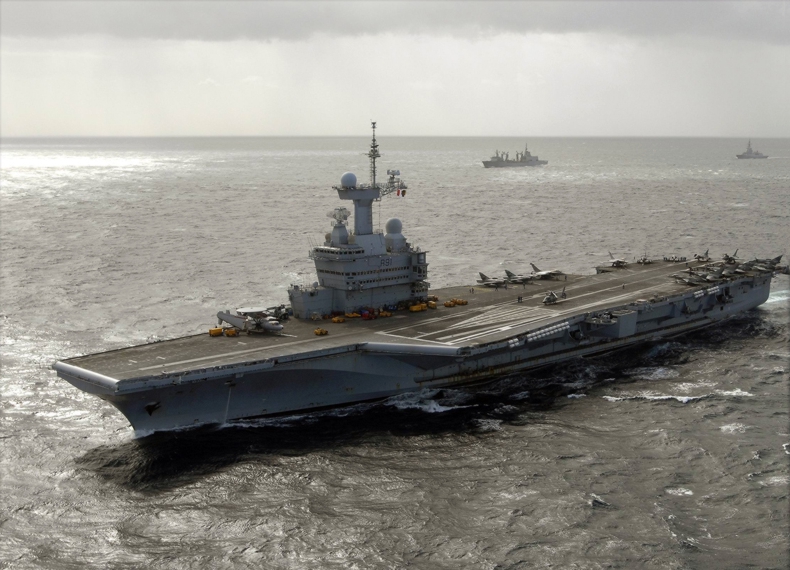
FS Charles de Gaulle (Ex-Richelieu) was designed back in 1975 as a successor of the Clemenceau class, two fleet carriers built in the late 1950s. She was to be the lead ship of a class of two, only one was completed. FS Charles De Gaulle was commissioned in 2001 and is now the flagship of the Marine Nationale, taking part in many engagements around the globe as well as NATO international exercizes. Only nuclear carrier in Europe, she is herself scheduled for replacement by a new 80,000 tonnes nuclear fleet carrier planned for 2035, the PANG. #marinenationale #charlesdegaulle #14july #bastilleday
Design of the class
The replacement of the Clemenceau class aircraft carriers (1965) was a long process started in 1975, which knew many tribulations along the way.
The French atomic carrier project: PA58/Verdun class
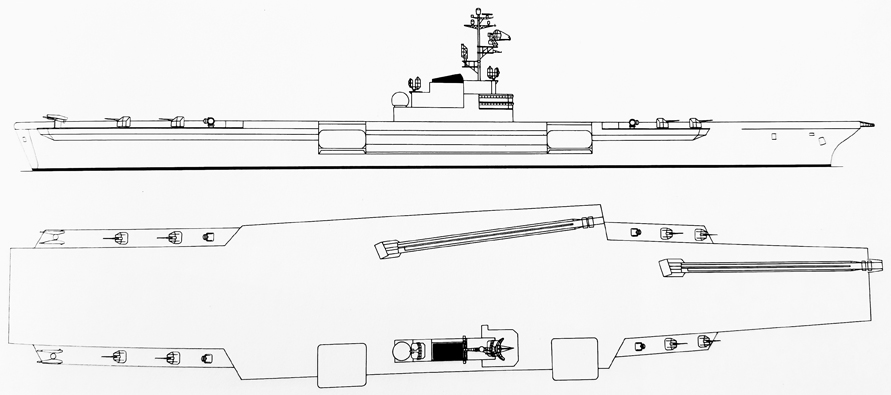
The PA58 were an early nuclear-powered successor to the Clemenceau class, at the time the latter were already approved and construction started in 1957. The next year in 1958 a brand new class was studied to be completed FY1969-75. The two “clem” were just already considered too small at 20,000 tons standard to operate new projected bombers (like the future Mirage IV), which limited the air group capacity. As soon as the PA56 design was approved, the admiralty planned a larger carrier dedicated to operate nuclear strikes. They indeed observed the struggle of the US Navy to have the USS United States built, and soon cancelled due to deterrence rivalry between the Air Force and Navy.
Having none of these exarcerbated rivalries, simple flexibility commanded that the Navy could share at least a form or tactical nuclear projection.
The project was named PA58 as started in 1957 but approved in 1958, and was soon sufficiently advanced that the name “Verdun” was approved for the first ship. This confirmed the choice also of honoring WWI heads of state (Clemenceau), Generalissimo (Foch) and battles (Verdun). To gain time, the design was essentually a “stretched PA56”. Both shared a lot in common, but the PA58 was simply made on a much larger scale. Some argued that it could hhave operated a navalized version of the Suf-Aviation Vautour jet bomber in development from 1956 and able to carry a small nuclear tactical bomb in its bay.
Construction was considered in 1958, discussions went on in 1959 to 1961, but the program was cancelled in 1961. Indeed in 1959, Charles de Gaulle was elected president and started to review the fundamentals of French deterrence program.
“Apparently, the PA58 alias Verdun was a much larger design compared to the PA54 given its projected displacement of 45,000 tons, inspired by USN Super-carriers of the time, but the length was the same (262 m pp, 286 m wl) whereas the hull’s width was larger at 34 m for a flight deck 58 m wide, quite an improvement.
The PA58 was propelled by Steam turbines on 4 shafts, producing a total of 200,000 shp, for a speed of 33 knots (61 km/h; 38 mph). Parking size inside was much enlarged as well as aicraft handling. The PA58 had two lifts admidships and wo capapults and an angled deck placed the same way as PA54. It was to be armed with two Masurca SAM systems placed at the end of the side sponsons and height standard 100 mm DP guns placed for and aft abaft the flight deck. The placement of these SAMs recalled the American Kitty Hawk class.
The air group would have been largely similar to the Clemenceau to the exception of a navalized version of the heavy Dassault Mirage IVM, which was envisioned. The plane weighted 20 tons which required significant modifications on the lifts and catapults compared to PA54. The air group nevertheless comprised a combination of ASW Alizé aircraft and Etendard fighter-bombers. In 1960 the admiralty saw delays accumulating due to financial problems and eventually envisioned a smaller, cheaper design without the Masurca SAM but it went nowhere and the whole program was discarded and abandoned in 1961. Later both the Foch and Clemenceau were modified to accommodate the AN52 nuclear bomb. A new “large flight deck” nuclear-powered carrier will emerge in 1990 and take the role of the former abandoned Verdun, the Charles De Gaulle.
Specifications of PA58:
Displacement 35,000 – 45,000 tons FL
Dimensions 265 m wl/286 m oa x 34m pp/ 58m oa x 7 m
Powerplant: 4 shaft Parsons turbines, 6 boilers 200,000 hp 33 knots
Armament: 8 x 100 mm, 2 Masurca SAM, 50 aircraft, see notes.
Complement 1800
The VTOL solution: PA75
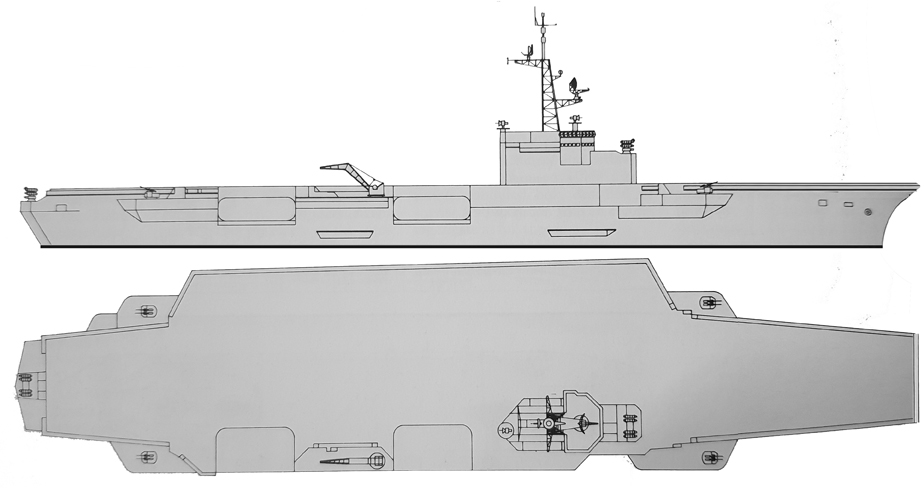
If the PA75 project was for a new VTOL carrier replacing FS Arromanches (a Warrior-class fleet carrier) and on the long run, potentially also the Jeanne d’Arc, rather than a true successor of the Clemenceau class. Many ideas were kept for the future design. In 1975 indeed a military program sent to the STCAN, DCN, in Paris had for object to study a nuclear propulsion project called PH 75, to be 208 m long for 46 m in beam and with a displacement of no more than 18,400 t but powered by a CAS230 nuclear reactor associated with two turbo-reducers-condensers, of 65,000 hp each and completed ny a sort of APU, two diesels capable of a range of 3,000 nautical miles at 10 knots. Top speed was setup at 28 knots. But it was a helicopter carrier with future capabilities to operated VTOL aicrafts. It nomonal park was 25 Lynx helicopters or 15 SA330 Puma for ground assault, or 10 SA321 Super-Frelon in a purely ASW configuration. Defensive armament comprised crotale SAMs and four twin 40 mm AA guns, DRBV-26, DRBV-51 radars and DRBC-32 FCS, DUBA 25 sonar, DECCA satnav system. Three were planned initially.
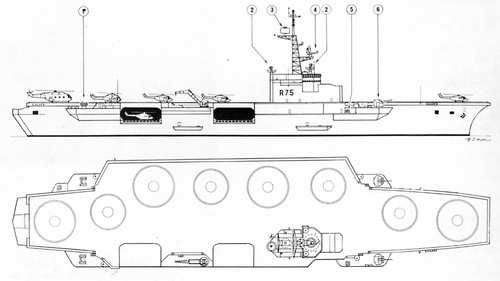
PA-75 in her original configuration – note the landing pads
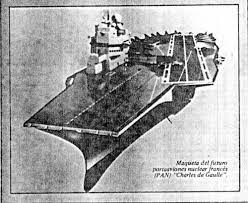 The choice of nuclear propulsion was dictated by the independence of France linked to foreign policy for fossil fuel. Nuclear fuel would spare the purchase of 1.5 billion liters of oil over twenty years. In 1977, PA-75 was extended to a new aircraft carrier, essentually a redesign of the Clemenceau, and an optional new generation aircraft carriers, of larger size. Both were nuclear but only upgraded to operat VTOLs (to be acquired as at the time Dassault had yet to offer a suitable model).
The choice of nuclear propulsion was dictated by the independence of France linked to foreign policy for fossil fuel. Nuclear fuel would spare the purchase of 1.5 billion liters of oil over twenty years. In 1977, PA-75 was extended to a new aircraft carrier, essentually a redesign of the Clemenceau, and an optional new generation aircraft carriers, of larger size. Both were nuclear but only upgraded to operat VTOLs (to be acquired as at the time Dassault had yet to offer a suitable model).
The project was completed in 1979, but construction studies were cancelled, while the whple The PA-75 Helicopter Carrier program was cancelled for a new PAN program or CATOBAR carrier with standard aicraft. Due to emergency in 1980, the alternative larger hull carrier was also cancelled for a same size ship as the clemenceau class due to drydock limitations. Vignettes: FS Richelieu (secretprojects.com)
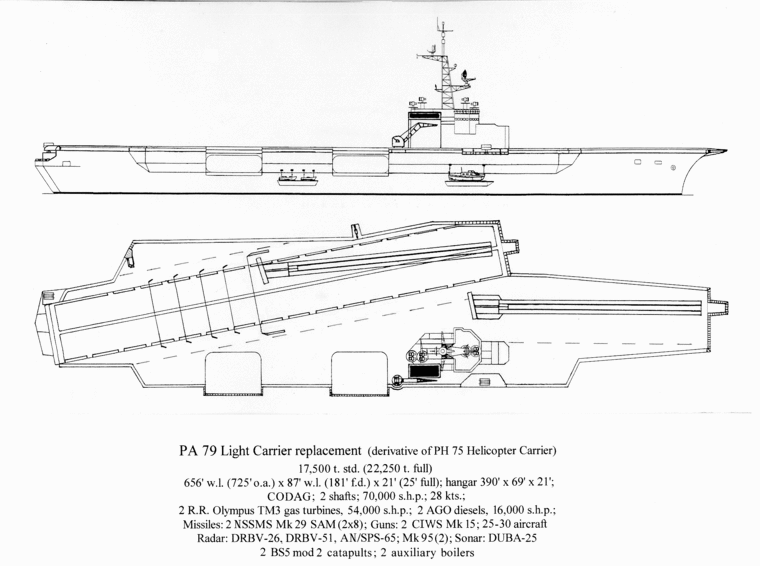
PA 79, a more advanced verison of the nuclear carrier (Verdun class)
Genesis of PAN 90
Confirmation of a CATOBAR carrier
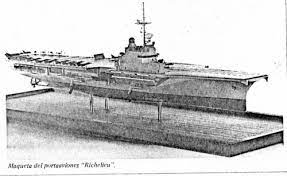 Requirement for a replacement was identified in 1976, but design of a replacement for the Clemenceau class started over a timetable of ten years, in 1978, for an entry in service thus planned FY1988. After eliminating the possibility of acquiring two STOVL carriers or more for the same budget, decision following the 1969 “plan bleu” was made to confirm French Nuclear Deterrence, while still maintaining for 1985 a fleet of five SNLE (SSBNs), two aircraft carriers (Still the Clemenceau class, modernized), two helicopter carriers (PA 75, later cancelled), 30 frigates and corvettes, two tankers, twenty SSK/SSN submarines, 35 sloops and many more misc. ships. The weight of the deterrence in the budget limited the surface fleet budgetary envelope for a new aircraft carrier, but after 1979 it was decided to stick to the CATOBAR (catapulting of aircraft, landing by arresting wires) formula. The construction of two aicraft carriers was also decided as not to impair French presence overseas (one carrier in maintenance, the other at sea at all times).
Requirement for a replacement was identified in 1976, but design of a replacement for the Clemenceau class started over a timetable of ten years, in 1978, for an entry in service thus planned FY1988. After eliminating the possibility of acquiring two STOVL carriers or more for the same budget, decision following the 1969 “plan bleu” was made to confirm French Nuclear Deterrence, while still maintaining for 1985 a fleet of five SNLE (SSBNs), two aircraft carriers (Still the Clemenceau class, modernized), two helicopter carriers (PA 75, later cancelled), 30 frigates and corvettes, two tankers, twenty SSK/SSN submarines, 35 sloops and many more misc. ships. The weight of the deterrence in the budget limited the surface fleet budgetary envelope for a new aircraft carrier, but after 1979 it was decided to stick to the CATOBAR (catapulting of aircraft, landing by arresting wires) formula. The construction of two aicraft carriers was also decided as not to impair French presence overseas (one carrier in maintenance, the other at sea at all times).
The choice of nuclear power

Yard model showing the carrier and its nuclear plant in cutaway
Based on this, French nuclear policy in 1970 saw the country rapidly setup a plan for civilian nuclear powerplants, which demultiplied after the 1973 oil crisis, when it was decided to adopt nuclear power as a main energy source as a national policy. Thanks to this expertise, and the one deployed for the Marine Nationale already from 1968, nuclear propulsion seemed to be a viable option for unlimited range, even if its means limiting the number of harbours hosting the carriers. Reliance on oil was also rejected for foreign policy reasons. France was also out of NATO at that stage and could not ensure oil delivery via NATO stocks in operation.
Indeed, France developed via the predecessor of TechnicAtome (founded 1972) GWC PAR K15 Pressurized Water Reactor (PWR) its first SSBN, Le Redoutable (launched 1967), before any experimental SSN. Le Redoutable was operational in 1971 and five more followed. Then came the Rubis class SSNs (1981) which had the world’s smallest nuclear reactors.
It awas believed that multiplying by two these reactors, the new PAN (“Porte-Avion Nucléaire” or nuclear aicraft carrier) would have the required output for a larger ship than the Clemenceau class, given the planned increase in weight and size of jets, a reserve of power for all lighting and electronics aboard, unlimited range before a core change each ten years during a great overhaul.
Construction
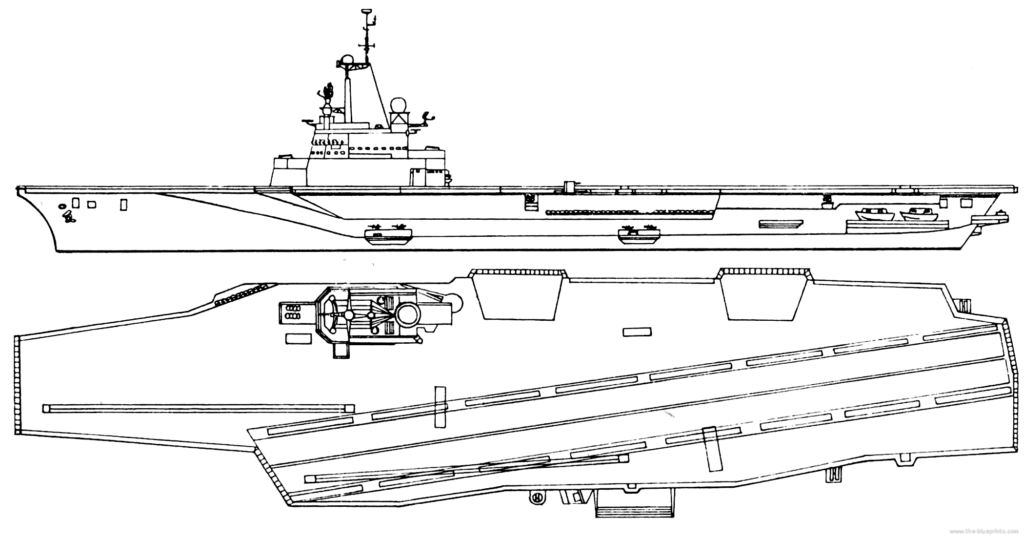
Early drawing of the carrier in 1987.
Based on this, design proceeded promptly at DCN placed in charge of the project. The PAN programme was really started for its technical aspects by 1980, when the Defence Council precised the for two nuclear-powered carriers of 35,000t, with catapults and arrestor gear capable of handling aircraft with a maximum weight of 22t. The schedule was pushed back from 1988 to 1992 for the first ship. But construction was delayed for budgetary reasons (new administration), and not placed until 1986. This was the first of many delays added to postponing indefinitely the second ship (PA2).
The construction of the Charles de Gaulle began on November 24, 1987, by stacking of elements in prefabrication and with the base structure started to be assembled in April 1989 at DCN shipyards, Brest. She was launched on 7 May 1994, but not completed before 2002. Indeed she was “armed” in the French sense on 28 septembre 2000, which could correspond to a completion. Construction was assumed “over” in 2000, but further modifications went on until her official service commission in May 2001. From 1987 to 2001 this amounted for an enormous fourteen years, but the construction program included construction of separate assembly between 1987 and 1989 with an official assembly starting really between 1989 and 1994. The setup of all systems between 1994 and 2000 has been an harrowing problems due to notably, budgetary priority changes and industrial challenges.
Construction represented 25% of DCN-Brest’s workload, between 1990 and 1996, mobilizing between 1,000 and 1,200 people for 13 million hours of work, 2 million hours of studies, 11 million hours for construction, not even including the galaxy of French subcontractors. Dutch, Swiss, US systems were also adopted. The budget, as often in these cases, skyrocketed. It went to 20 billion francs, 2/3 of which was for the carrier itself (readjusted as approximately 3 billion euros) and so approximately 2.2 billion US dollars. Still, this is to compare to the 4.3 billion US dollars for the USS Ronald Reagan entering service the same year, roughly half the budget. Capabilities of course, are function of the air group, also much reduced in proportion.
Naming and Impact
After all, at 42,500 tonnes, she was the heaviest warship launched in Western Europe since the 1950 carrier HMS Ark Royal. She is (still today) the one and only nuclear carrier in Europe. She is far larger than others European carriers such as the Italian Cavour or Garibaldi, Asturias, the previous British Invincible class. The contemporary ex-Soviet, Russian Kuznetsov is however larger at 58,600 t (57,700 long tons) full load, but propulsion is not comparable. Only now the new Queen Elisabeth class are greater in Europe at 65,000 tonnes; but they did not have the same range. This still made France today part of a very restricted club of three nations with CATOBAR nuclear carriers with the US and now China.
Curiously, if the PA 58 was to be named Verdun, the PA 75 had not name, the one initially chosen in 1986 for the new PAN was “Richelieu” a traditional name in the French Navy honoring the memory of the Duke and Cardinal de Richelieu, illustrious politician and funder of the French Navy with Colbert later. But the project was renamed “Charles de Gaulle” by then Prime Minister Jacques Chirac as a political gesture related to his own party, claiming iheritance from the general since 1969. The name is usually contracted as “CdG” like the Paris airport, sharing the same name. It shares this origin to the Nimitz class USS Dwight D. Eisenhower, also a WW2 general becoming head of state postwar.
Second Carrier: The ill-fated “PA2”
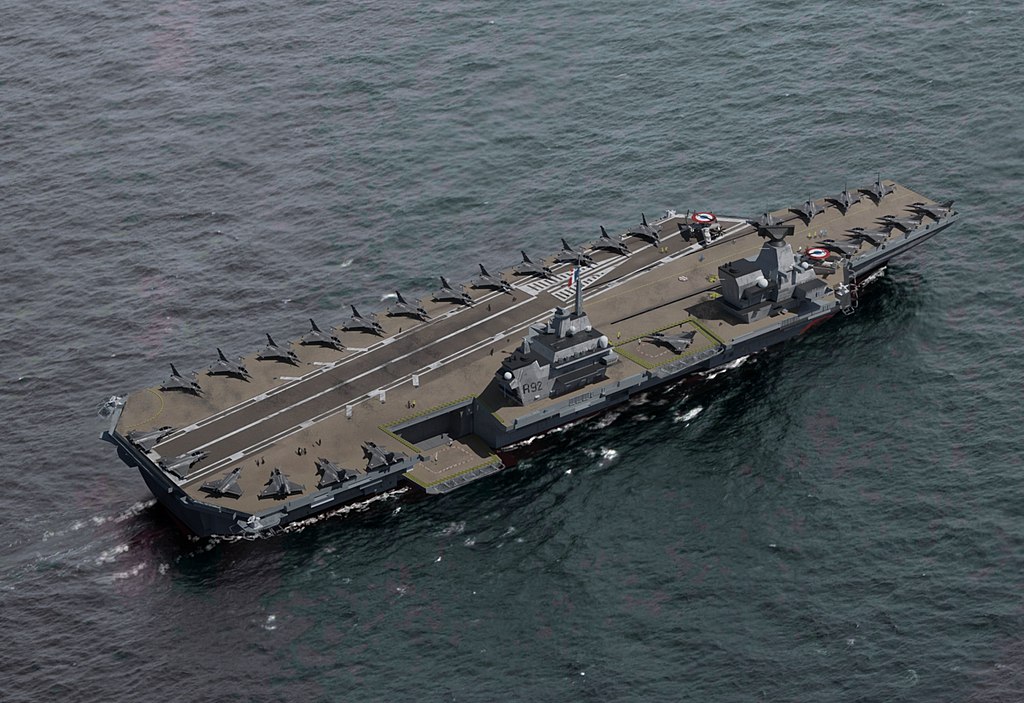
Rendering of PA2 as initially planned in the 2000s, very similar to the QE2 class
Having a two-carrier force was a no-brainer for the Marine Nationale, as it operated from the 1960s to the entry into service of CdG in 2000 with two ships, Foch and Clemenceau. The base principle was simple: Having one carrier at sea at all times while the second was unavailable for maintenance, repair or refit. So it was underestood in 1987 when pre-contrstruction of Cdg (PA1) started, that she would be followed by PA2 (unnamed) in the same yard in Brest. Given the fact CdG was launched in 1994, this means a laying down ceremony in 1995, and (hopefully) shorter completion perhaps in 2004-2005. However it was never meant to be.
Two nuclear-powered aircraft carriers (PAN) selected were initially to be named “Bretagne”, scheduled for commission in 1992, and her twin “Provence” for 1996, however, order for the 1st ship later renamed Richelieu (and then Charles de Gaulle) was postponed to 1987. The 2nd was unscheduled.
In a post-cold war budjetary constraints context, and despite the vidid objections of the Navy, the PA2, at first a simple sister-ship, was fatally to be delayed as new policies towards the military dictated massive deflation of costs. The “dividends of peace” made maintenance of 1980s-planned expenditures, simply unjustifiable for the taxpayer. The launch of the second aircraft carrier (PA2) was indeed postponed, and eventually canceled by Presidents Sarkozy, and confirmed under President Holland’s administration. Studies were be restarted during the LPM 2019-2025 just to take advantage of engineers and technicians’s skills, who worked on the Charles de Gaulle programs ans so PA2 became a replacement for the Charles-de-Gaulle.
However PA2 initially was to be recast, from a sister ship, to a “third Queen Elisabeth”. Indeed, at a time the Royal Navy looked to acquire a new pair of fleet aicraft carriers, France was thinking about a second carrier alongside CdG.
This was mostly a political drive of commonality to reduce costs, despite the objections of both the CdG constructor, DCN, and the naval staff. And so, under study by DCNS (Brest) and the Yard STX France (Saint-Nazaire) having a new, large enough dockyard for a 280 m ship (this was a renown cruise shipbuilder), the programme aimed at building a common Franco-British design.
As often in these multi-national projects, politically driven, industrial disagreements are often the cause of failure. This was no exception.
In 2000, it was the French Senate that took into account recent geostrategic changes, pleading to start the construction of a second aircraft carrier in agreement with the consistency of the choices made by the Navy, and an additional investment required wa scalculated of 14 billion francs or 2.13 billion euros, even independent of the air group, but ensuring permanent availability.
Preparation of the White Paper on Defense and National Security published on June 17, 2008, spoked of “a post-Mahanian scenario of permanent projection” which further pleaded for the PA 2, but at the expanse of the number of Aquitaine class frigates and Suffren class SSNs. The President at the time enhanced cooperation at European level and a better integrated European defense policy pushed towards an opportunity of cooperation while the need of a carrier for the Europe-Asia line between Djibouti and Reunion and Asia so from there to Polynesia, in the context of a rapidly ramping-up PLAN also pleaded for the PA2. It happened that the Asian sitation preoccupied the RN as well.
The white paper underlined that a conventional carrier was a perfectly viablme optionfor several reasons we will not dwelve in detail. Fact is, it met RN requirements: With the Strategic Defense Review (SDR) of July 1998, the British MoD suggested that the Royal Navy should equip itself by 2012-2015 with two aircraft carriers displacing c30,000-40,000 tons for 50 aircraft, to replace the Invincible-class ships, limited to ASW. By 1999 already French authorities submitted a cooperation and the “Future Carrier Working Group” was established, discussions going on between the French DGA and the British DPA on their configuration, setting up specifications and industrial montage and shares.
It appeared British engineers lost skills in conventional aircraft carriers and it was underlined that four options were compatible with French preferences, notably the CATOBAR or CTOL configuration, and STOBAR option. By january 2001 the STOBAR option was eliminated and by July 2002 the French MoD agreed on a principle of three carriers of the Future CV with 2 for the Royal Navy and one for the Marine nationale. But by september the CATOBAR option was also discarded, for an “improved STOVL”, which was “flexible”, so with a modular sky jump removable to be replaced by a catapult (including a future upgrade for British carriers as well depending on the air park). In 2003 a French consortium with EADS, Thales, DCN, Alstom proposed a 50,000 tonnes CATOBAR which was rejected. Admiral Sautter argued for a conventional carrier, as more efficient than a nuclear one cost-wise due to the radical oil price fall since the 2000s.
By the end of the 2010s, UK maintained discussioned on a STOVL “CATOBAR-compatible” to operate the Rafale, while the British choice of the F-35 was firmly established.
But the PA2 was definitely buried by the new (Hollande) administration in 2012. It seems too much competition notably between Thales et BAe Systems led to this state.
The result of this for France however was disastrous. The Marine Nationale is left with a single carrier, more costly htan either two QE2 carriers for the RN, which has the advantage of this redundancy in operations. It could be argued also that the US-led multinational F-35 Lightning II is infinitely superior to the Dassault Rafale (added to a greater air park), a 4.5 gen. aircraft, although its introduction into service on the QE2 was a harrowing mess, and still ongoing.
2020 Reboot: The PANG

The new PANG (ex-PA1) relaunched during the COVID pandemic, confirmed definitely in 2020, would be far larger than the QE2,nuclear-powered, and this time capable of operating a far larger air park. It is looking towards US carrier standards and Chinese new carrier standards as well. In short, the first European “supercarrier”. PANG stood for “Porte Avions Nucléaire/Nouvelle Generation” or “next-gen nuclear carrier”. It inherits nothing from the previous CVL (or PA2) and started from a blank page given the new requirments in the air group, with the integration of the planned SCAF or “Future Combat Air System” (6th gen. multitole aircraft built in European cooperation) and an UAV (perhaps the Dassault NeuRon) or another new multirole Naval Combat Drone aimed at creating a new integrated fight combat squadron mixing human pilots and drones integral to the SCAF system.
However there are still questions about the program.
-The programmation of a second carrier still has not been confirmed. Solutions like a second carrier financed and shared by European partners is for the moment in study.
-The completion of PANG is expected in 2035 for sea trials is tributary to any political change in France. No cancellation is admissible after the 2021 law adoption, but delaying is possible in any new administration. The political climate in France as of 2023, pending new elections in 2024, is extremely volatile.
-Agreements to share with the US the new Electromagnetic Aircraft Launch System (EMALS) catapult system are still ongoing.
-The air group is highy dependent of international European cooperation. The main drive behind SCALP (France and Germany) has been delayed with even cancellation concerns following Chancellor Scholtz’s announcement of the purchase of F-35s following the 2022 invasion of Ukraine by Russia. The F-35 would be completely able to take on the tasks of the future SCALP under a shorter delay. This could cause further delays for a program scheduled for a first flight of the NGF in 2035, and associated drone of the combat cloud in 2040, or complete failure admist industrial disagreements. Already Dassault announced by mid-2022 to be able under “short notice” to deliver a viable 6th gen aircraft if the program was to be cancelled. Nevertheless, cooperation between Airbus and Dassault is ongoing on the program.
Detailed Design of Charles de Gaulle
Hull and general design
Starting with a Hull virtually identical to those of Clemenceau, the choice was made at the time because of the maximum accommodation of the building dock at Brest Naval Dockyard (the largest in France). However, the requirement to operate heavier aircraft led to the adoption of a broad United States Navy-style flight deck, with substantial overhang and served by two deck-edge lifts to starboard. A configuration radically different from the Clemenceau, which flight deck appeared quite narrow and more in line with an Essex-classs ship.
The hull displaced 42,500 t (41,800 long tons) full load for 261.5 m (857 ft 11 in) in overall lenght, and a waterline beam of 31.5 m (103 ft 4 in), overall deck width of 64.36 m (211 ft 2 in). At the top of its mast, the Charles de Gaulle is considerably taller than the Clemenceau class, at 66.5 m (218 ft 2 in). It is also draftier at 9.43 m (30 ft 11 in), compared to 32,780 tons FL, 265 m (869 ft) oa, 51.2 m (168 ft) overall in width and a draught of 8.6 m (28 ft).
Powerplant
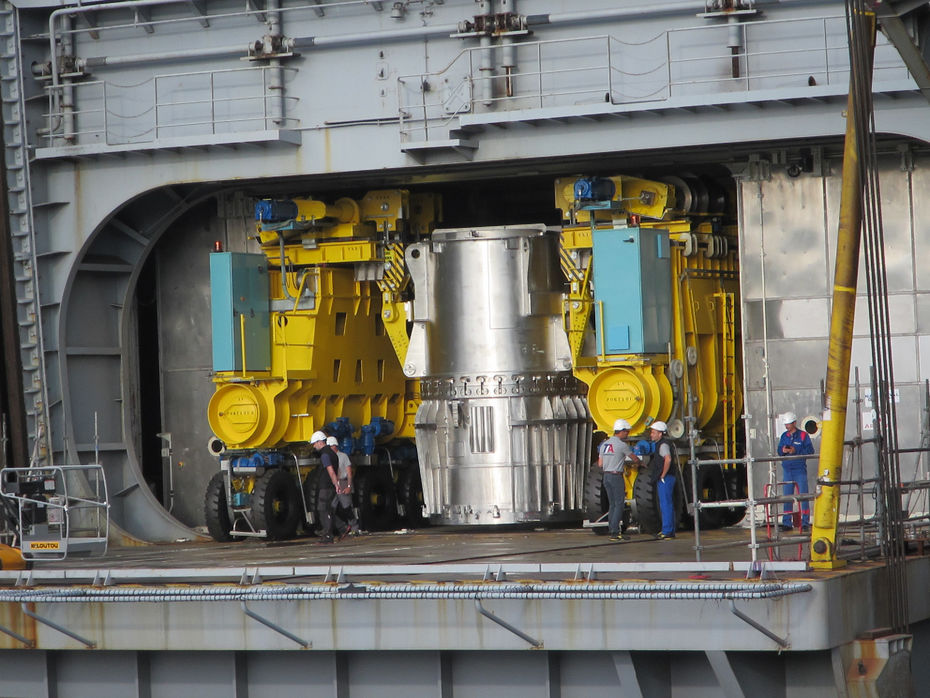
Nuclear core change during CdG latest 8-month midlife upgrade/refit from February 2017 to September 2018. A much shorter delay for the same on a US carrier. Official photo from Technicatome
The propulsion system is based on PWR reactors derived from the ones developed for the SSBNs of Le Triomphant class, the planned replacements for the Redoutable class back in 1990. Concern were expressed regarding the low maximum speed of 27kts procured by these, with the only alternative being to install a third reactor in what was already a tight design. The secondary steam generators supplied steam to the catapult and to four turbo-alternators of 4,000 kW, which provided power to two independent switchboards. There are also four diesel alternators each of 1,100kW to provide power when alongside or in emergencies.
In the end, the powerplant comprised two Areva K15 pressurised water reactors of 150 MWt each (LEU < 20%) wearming steam for two Alstom steam turbines, with a total 61 MW (82,000 hp) shaft power. This was completed by the four diesel-electric systems described above. This was on two shafts, and for 27 knots (50 km/h; 31 mph) max speed, but on nlimited distance with 20–25 years before core change. In reality it was later established every 7.5 years. Endurance was mostly limited by the 45 days of food aboard, alleviated by RAS ships as part of the battle group. In addition to the range, nuclear reactors also enabled the carrier to accelerate to 20 knots in just 4 minutes and reach 27 knots in 7 minutes. This was far better than the Clemenceau class, in addition to the fact their steam engines needed a consierable delay to heat up, as compared to the CdG reactors, always active. These performances enabled superior evasive maneuvers or to catapult its heavy Rafales at max load in better safety. Itwas estimated that for the same, the Clemenceau class would have needed six additional boilers and still required more than 30 min. of delay to rteach the necessary output. The machinery needed a crew of 55 to operate. Nominal power, 83 000 ch and a top speed back to 27 nœuds, was only needed to ensure safe catapulting of the Rafale in max load configuration by absent wind. Not only the top speed was infarior by 5 knots to the Clemenceau class, but their power in comparison was 126.000 shp. This was considered not an issue given the objectives at hands, once it was understood there as no way to stack three reactors in the limited allocated space given the dimensions of the hull. The range compensated for it. In fact, the reactor enclosures weights 900 tonnes but in a 10 meters high, 10 meters diameter space, making it possible to carry additional avgaz and ammunitions (see later). There was also bunkarge for 1,000 tons of diesel, not only for emergency use, but also allowing to refuel its own escort in RAS.
Protection
The propulsion machinery and ordnance magazines are housed within a protective armoured box designed to survive a 90° collision (ramming) with an escorting frigate at full speed. Incidentally, it could also resist war damage, mine or conventional missile attack. However unlike US carriers, there is no kevlar additional protection for the ammunition magazines. In fact, according to the engineers who worked on the PA 2 project during the time of Franco-British cooperation, the very compartmentalized design of the hull of the Charles de Gaulle and its advanced security systems (in particular firefighting), make it a building able to stay afloat after taking several torpedoes and missiles.
The ship is also fully NBC protected, with hatches and doors full sealing, hangar sealing and slight overpressure with the air conditioning system, NBC detectors, and warshover sprinklers on the flight deck.
Armament
In the 1980s it was obvious that the new carrier was to be protected only by missiles. However autocannons are also part of the panoply which is rather short range. The long range is assumed by escorting frigates and destroyers as planned. This is the same philosophy as on US carriers, although the Sea Sparrows (on the Nimitz) are longer range, while the CIWS are perhaps better suited to missile-busting at short range although Mistrals are specialized for saturation fire in a 10 miles bubble.
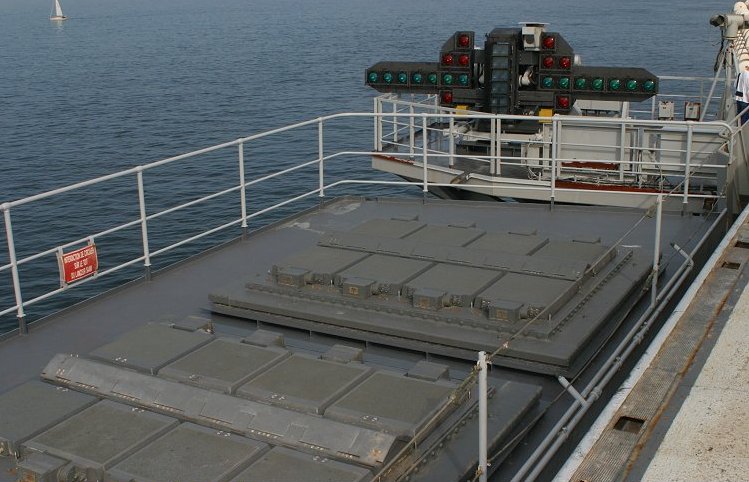
Aster SAAM
It was adopted after some tractations. A Franco-Italian system, the Aster SAAM was also adopted by the new FREMM Frigates. The system is a radar-guided anti-missile system being developed jointly by France and Italy, launched vertically (VLS) from modules located forward of the island to starboard, and outboard of the flight deck to port. In total four 8-cell A-43 Sylver launchers carrying the MBDA Aster 15 surface-to-air missile were installed on Charles de Gaulle. The Aster 15 is a Solid propellant, two-stage motor missile with a flight altitude of 13 km using Inertial guidance with up-link and Active RF seeker for the final run, proximity fuse.
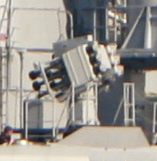 Sadral launchers: Mistral IR point-defence missile, for the lower range. It comprised two sextuple cell Sadral launchers, carrying the Mistral short-range missile. It is remote controlled, designed to answer low flying aircraft (or drones now) and inbound anti-ship missiles. The launcher has an optronic suite with both TV and IR cameras, operated by a single operator from a console within the ship. Reloaded of the six launchers is made in about 5 minutes. The Mistral 1 is a seeking surface to air missile capable or max range of 5 km (), altitude of 3 km (). It was replaced by the Mistral 2 in the 2010s with a 6km range.
Sadral launchers: Mistral IR point-defence missile, for the lower range. It comprised two sextuple cell Sadral launchers, carrying the Mistral short-range missile. It is remote controlled, designed to answer low flying aircraft (or drones now) and inbound anti-ship missiles. The launcher has an optronic suite with both TV and IR cameras, operated by a single operator from a console within the ship. Reloaded of the six launchers is made in about 5 minutes. The Mistral 1 is a seeking surface to air missile capable or max range of 5 km (), altitude of 3 km (). It was replaced by the Mistral 2 in the 2010s with a 6km range.
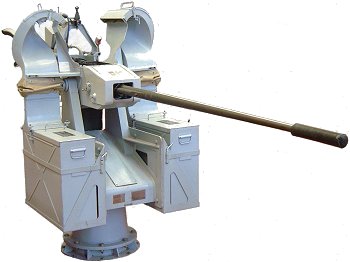 20mm autocannons:
20mm autocannons:
The third and last protective bubble was thought to deal against asymetric threat (like kamikaze fast boats) and helicopters. It comprised eight Giat 20 F2 Autocannons in the original configuration. A derivative of the famous Swiss Oerlikon of WW2 fame, this variant used a gas unlocked, delayed blowback feeding system for a ROF of 900 round/min at 1,050 m/s (3,400 ft/s), elevates −15° to + 65° at an effective range up to 1,500 m (4,900 ft) against aerial targets.
In 2019 it was replaced by three Nexter Narwhal autocannons. Specs +75°/-20°, ROF 800 round/min, MV 1,050 m/s (3,400 ft/s) range 1,500 m (4,900 ft) against aerial targets. These are RWS, autonomous unmanned systems.
Air Facilities
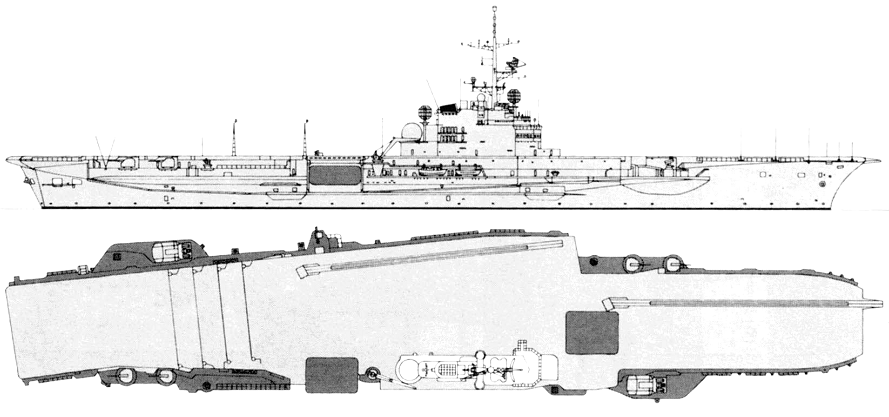
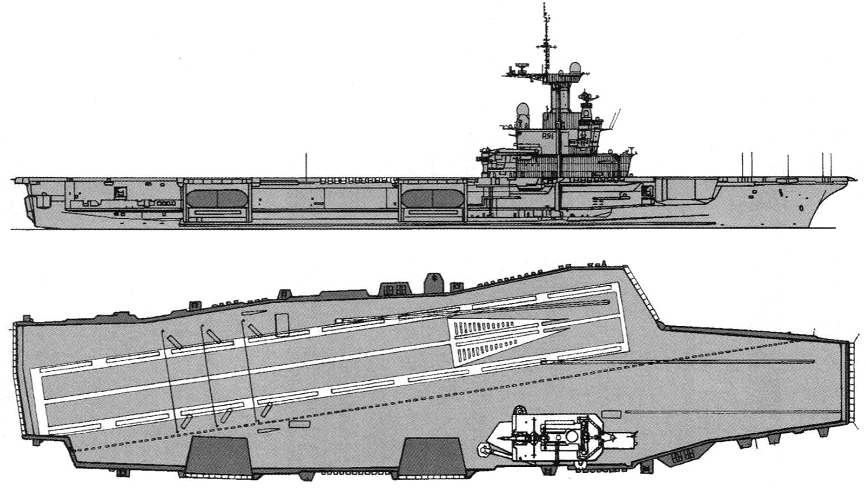
Clemenceau and CdG class compared. It’s easy to see the differences in deck space.
Flight Deck:
The 12,000m² (172,000 ft sq.) angled deck is 193m (633 ft) in length and, set at 8° to the ship’s axis. The forward catapult is offset to port, and intrudes on to the angled deck. It is therefore not possible to conduct take-off and landing operations simultaneously, the advantage of this arrangement is that it frees a large parking area to starboard which can accommodate six aircraft. The adoption of nuclear propulsion has enabled the island to be located forward of the two deck-edge lifts, thereby preventing mutual interference between the latter and take off operations using the forward catapult. Landings are further secured by the SATRAP active stabilisation system (see later).
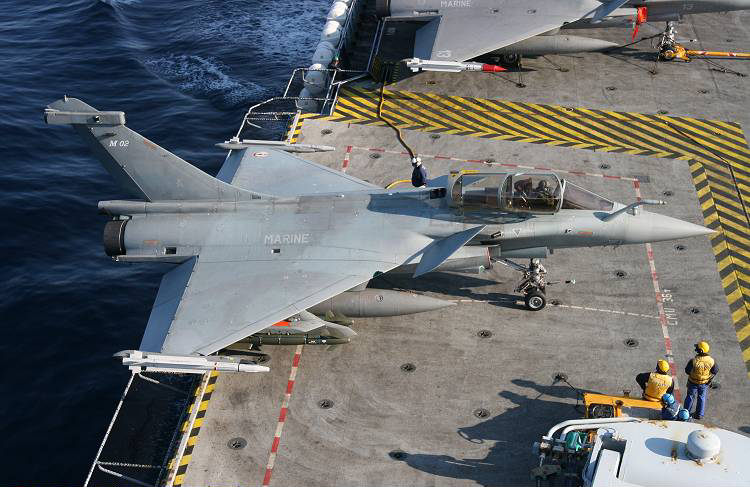
Lifts:
Unlike US Carriers with a larger air group (+60), CdG only has two 21 x 12m (68 ft x 39 ft) lifts, both side ones located starboard, island’s side. Each of the lifts has a capacity of 36t, enabling two aircraft to be transferred simultaneously between the flight deck and the hangar however for quicker operations. It should be noticed that if the E2C, Super Etendards had folding wings, it was not the case of the Rafale.

Hangar:
The latter has a length of 138 m (452 ft), for 29m in width (95 ft) and 6.1m in height (20 ft), representing 4,002m² of deck space (43,000 ft sq) and 24,412m³ (858,000 cu ft) in volume. It is divided into two bays. It can accommodate about half the air group, the remaining aircraft being kept permanently on deck.

Catapults:
The two US-designed C13-3 75m (246 ft) catapults (same type as the Nimitz class carriers), so again, half as on the latter, are capable of accelerating a 22t (4,400 Ib) aircraft to a take-off speed of 140kts. They have been largely built by Ruelle, based on the original steam-hydraulic model. They were later upgraded to launch a 25 ton (5,000 Ib) aicraft (like a fully loaded Rafale or E2C Hawkeye).

Arrestor Cables
The three 10 cm (4.25-in) arrestor wires and their Mk 7 Mod 3 hydraulic brakes were made in the Netherlands. One catapult was located on the angled deck, while the other serves the forward end of the flight deck.
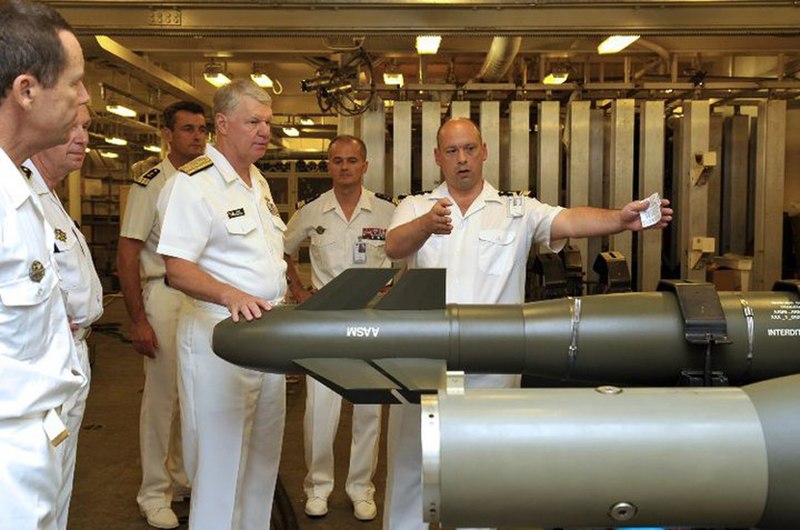
Avgas and ammo storage
Despite its restricted size, CdG carries 3,400 tons (6.8M Ib) of aviation fuel and 600 tons (13.230 ib) of ammunition, in inert state (sparated warheads). In intensive operations this means the carrier needs resplenishment only once a week for aviation fuel to maintain a potential at 70%. In Comparison the Clemenceau class required 1,000 tonnes (22,000 Ib) of fuel oil every 3 days, and that was for propulsion alone. This procured an increase in general safety as RAS maneuvers made both ships vulnerable to a possible submarine attack.
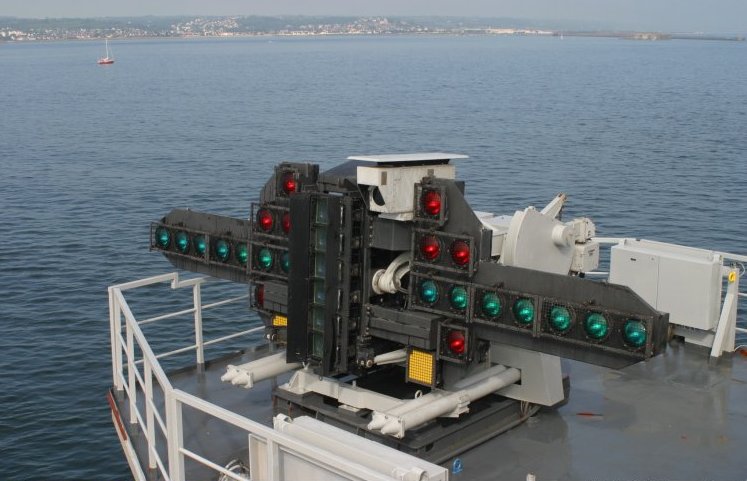
Landing Systems
For deck landings, the CdG also uses the following:
-SATRAP ship stabilization system. To reduce roll, yaw and list, coordinates via a centralized computer, the action of two pairs of stabilizing fins and a set of mobile masses (240 tons). The list is reduced to 1° by sea force 3-4, 3° by 6.
-3rd generation main optic (OP3) mirror, with IFLOLS optics.
-New generation laser landing aid device (DALAS-NG), adjustable turret, optronic detector, Moray IR thermal video camera
-Two MOVLAS systems (Manually Operated Visual Landing Aid System) in case of OP3 failure, installed in 10 minutes on the port side
Air Group Maintenance
The Charles de Gaulle technical group provides a 24H service from a stock of more than a million spare parts, several workshops and hangars, two reactor test benches. Availability rate of the Rafale is 94%, Hawkeye over 90%.
Air Group
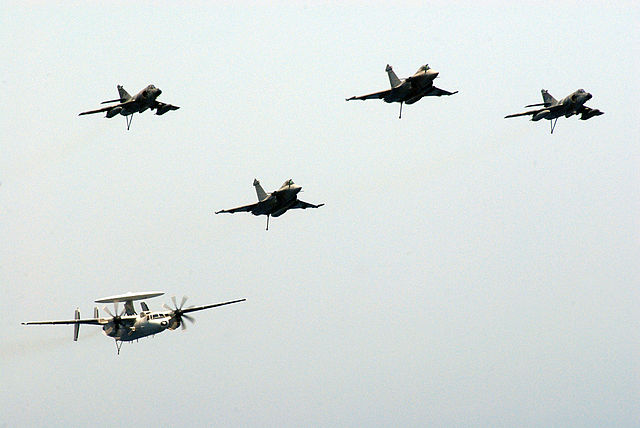
The major problem experienced with the PAN project has been the provision of suitable aircraft. Development of the Rafale ACM interceptor has been delayed, and completion of Charles de Gaulle has been put back to 1998 because of this and other issues. In the end, the entry into service of the final Rafale M (which had priority on the Dassault Rafale omnirole program) entered service in 2002, from the first tests in 1999 (see later). This means when she entered service, before that there was (potentially, it was never deployed on the CdG) the venerable F8E FN Crusader as interceptor. The Super-Etendard was the main assault model, but it was also scheduled for replacement.

As of 2001, her nominal air group comprised 40 aircraft: 2 Rafale-M Block 1, 29 Super Étendard, 2 E-2C Hawkeye, 2 Super Frelon and 2 Dauphin helicopters.
By 2011, 36 Rafale-M (No Super-Etendards), 3 E-2C, 2 NH-90, 3 Dauphin. The Rafale went through series of improvements to take over the missions of the Super Etendard and act as Interceptor, Strike Aicraft, Antiship Aircraft if needed. With the AM39 block 2 Exocet, the range is between 50 and 70 km, so the carrier aircraft is generally detected well within that range. The Rafale M range is circa 1,850 km (1,150 mi, 1,000 nmi) on penetration mission with three tanks.
Rafale M:
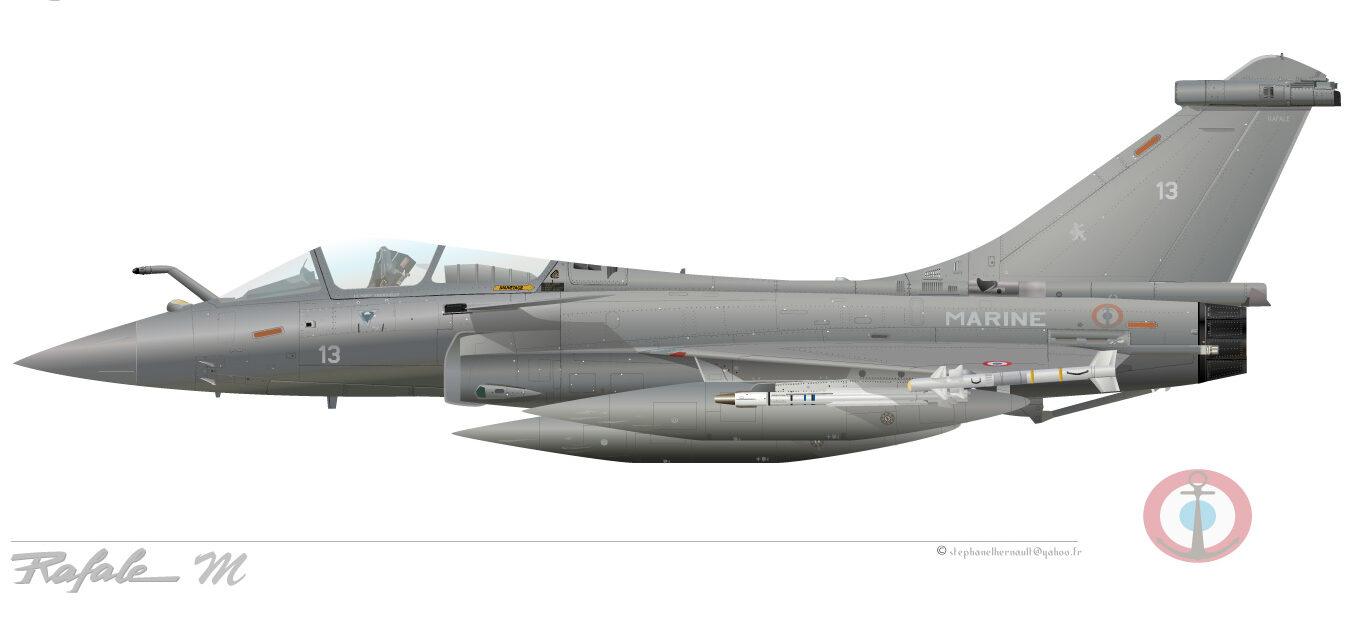
Rafale M, rendition by stephanelhernault at yahoo.fr, creative commons.
The Rafale program went back to 1986 as a replacement for the Mirage 2000. It was eagerly awaited in the Navy due to the planned replacement of the antiquated F8E Cusader and aging Dassault Super Etendard. The program was plagued by delays following the fall of the USSR. The first of two Rafale M (‘maritime’) prototypes, M01, made its maiden flight on 12 December 1991, followed by the second on 8 November 1993. They were air force variants with a reinforced structure to operate aboard ships, provision for a tail hook, built-in ladder and so this increased weight by 500 kg (1,100 lb). Since France has no land-based catapult test facility, catapult trials were carried out in mid-1992 and early 1993 at NAS Lakehurst, New Jersey.
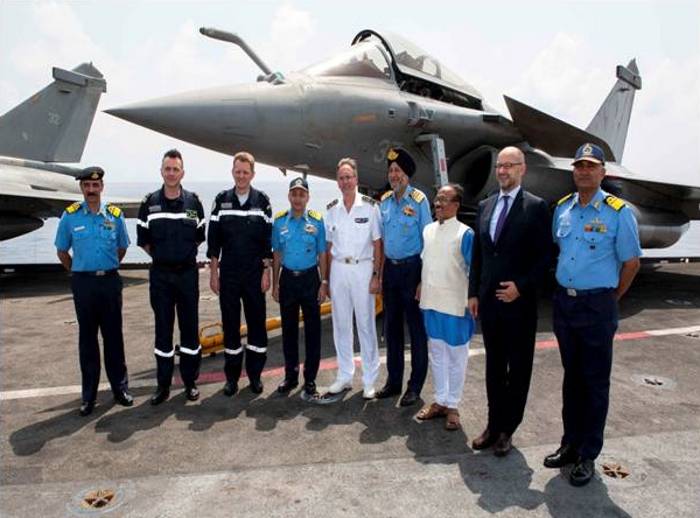
Off Goa, Chief Minister Laxmikant Parsekar and Vice Admiral SPS Cheema of the Indian Navy stands with French naval officers on the deck of the Charles De Gaulle; Discussions ported on the adoption of the Rafale M Block 4 on the new carrier INS Vikrant in construction.
First shipboard trials started on FS Foch in April 1993. Landings and launches from FS Charles de Gaulle in July 1999. It was adopted officially in 2002. As of today, the Rafale is the main air group component with 36 aboard (max capacity). As of today they are of the multirole F3R standard. The path is in ways similar to the one followed by the USN, with a single multirole model now, the Super Hornet (complemented by the Prowler and Hawkeye). I should be added that unlike the F-35 and like the super Hornet, the Rafale is capable of “buddy-buddy” air resplenishment for extra range.
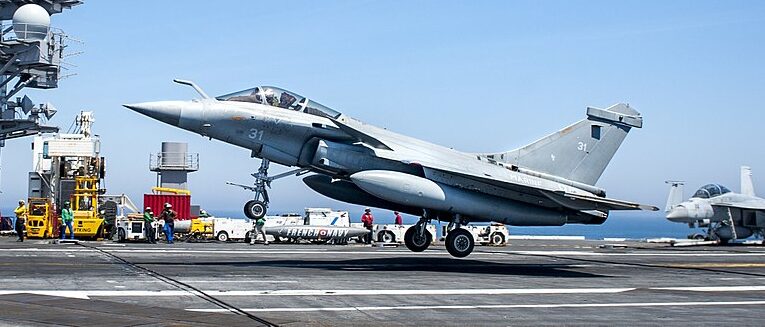
Rafale M taking off from USS George H.W. Bush during an interoperability operation. During CdG overhauls and planned availability, not to loose their edge, French Pilots are detached on Nimitz class US carriers. Interoperability exercises, on Bush or Roosevelt among others, also gave the opportunity to F-18 Hornet pilots (or other models) to take off and land on the CdG and for deck crews to compare organization and procedures.
Dassault Super Etendard:
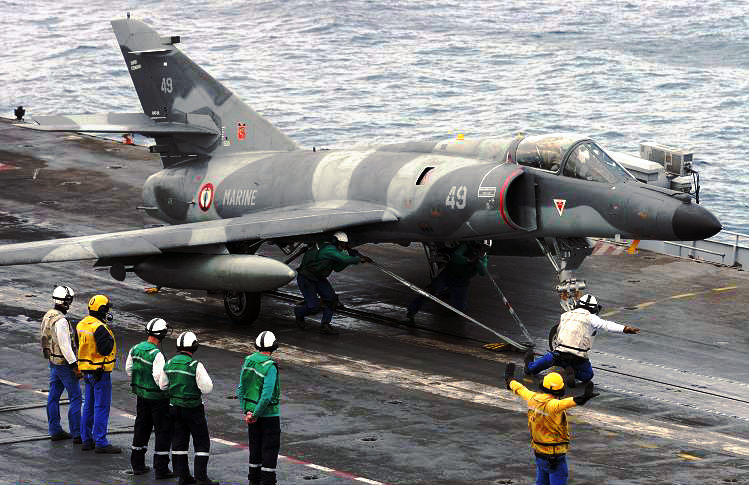
Replacement for the 1950s Etendard IV deployed on the Clemenceau class, this “legacy” aircraft was the main attack model of the Navy for decades, notably famous for carrying the Exocet antiship missile. It was thus tasked of antiship and ground attack missiles with a large payload but in the 2000s, lacked modern ECM warfare equipment and had a limited radar. The “old dog” made her maiden flight in 1974, deliveries started in 1978 with Flottille 11F. Clemenceau and Foch carried 16 of them for most of their career. They saw action on Lebanon (Operation Olifant), went through upgrades on the 1990s to add new capabilities (SEM), seeing action over Serbia in 1999, Operation Enduring Freedom, Mission Heracles in 2001 from Charles de Gaulle over Afghanistan, Operation Anaconda and others until 2011 working to designate targets to the 1st Gen. Rafales.
In March 2011, they were deployed with TF 473, over Libya, paired again with Rafales on interdiction missions. The remaining ones were in 17F until retired from 12 July 2016, after 42 years of service and a last mission in Operation Chammal over Iraq and Syria late 2015.

CdG (R91) stern view underway in 2009, showing its batch of Super Etendards, which were retired in 2014.
E2C Hawkeye
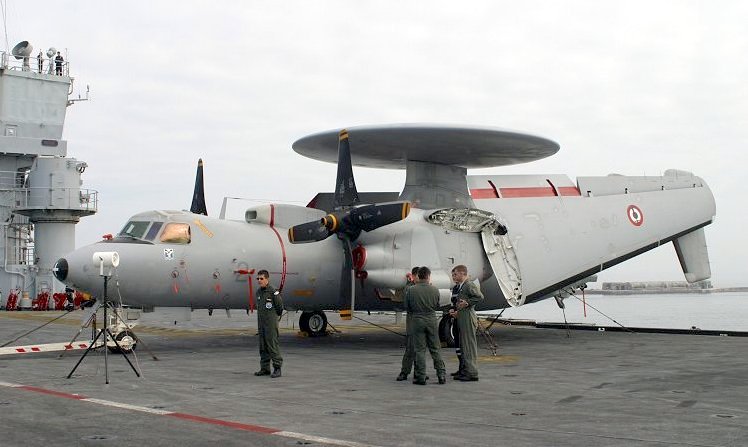
Charles de Gaulle is the first European carrier to deploy the 1960s Grumman E2C Hawkeye, used for long range warning, surveillance, coordination and electronic warfare. Of course landing such a 20 tons beast is an issue on such as small deck. The CdG operates two in a regular basis for combat patrols offshore. They were upgraded with 8-bladed propellers (NP2000 program) and by April 2007, purchase of additional “suer hawkeye” was approved by the US DoD. They serves in Flottille 4F from 2 July 2000. Land station is Lann-Bihoue. They few over Afghanistan and Libya notably. By 2019 French Minister MoD Florence Parly announced 3 new E-2D Advanced Hawkeyes purchased FY2020.
Helicopters
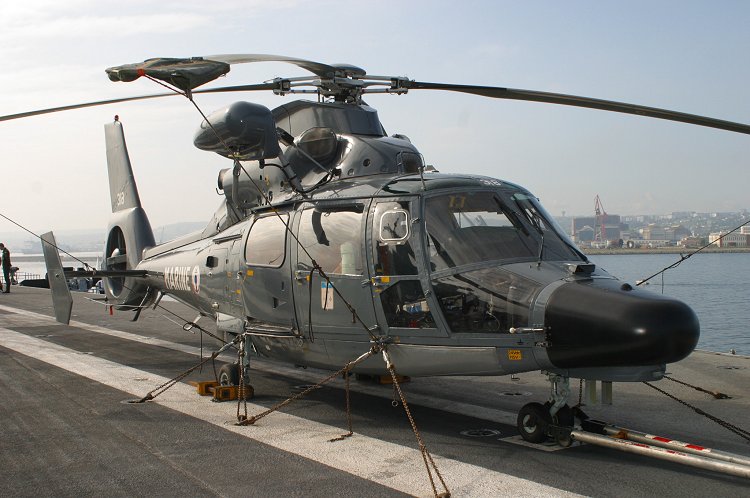
The main ASW plane of the French Navy has been the Breguet Alizé, a sturdy turboprop plane introduced by 1961, capable of 2,500 km endurance, was only active last on FS Foch, and followed its retirement. On CdG, helicopters on board are tasked of ASW, SAR, liaison missions. Two models were selected for the carrier, the old (1966) but massive (13 tons) and reliable SA 321 Super Frelon, mainly used for ASW, and the more nimble (4 tons) AS 342 Dauphin, apparently for a short time. As of today, the AS565 Panther and transport model H225M Caracal are used for spec ops. The NH90 Caïman replaced the Super Frelon. Typically, The CdG now is carrying one AS565 Panther ISR for ASW and two AS365F Dauphin Pedro for SAR, plane guard and liaison.
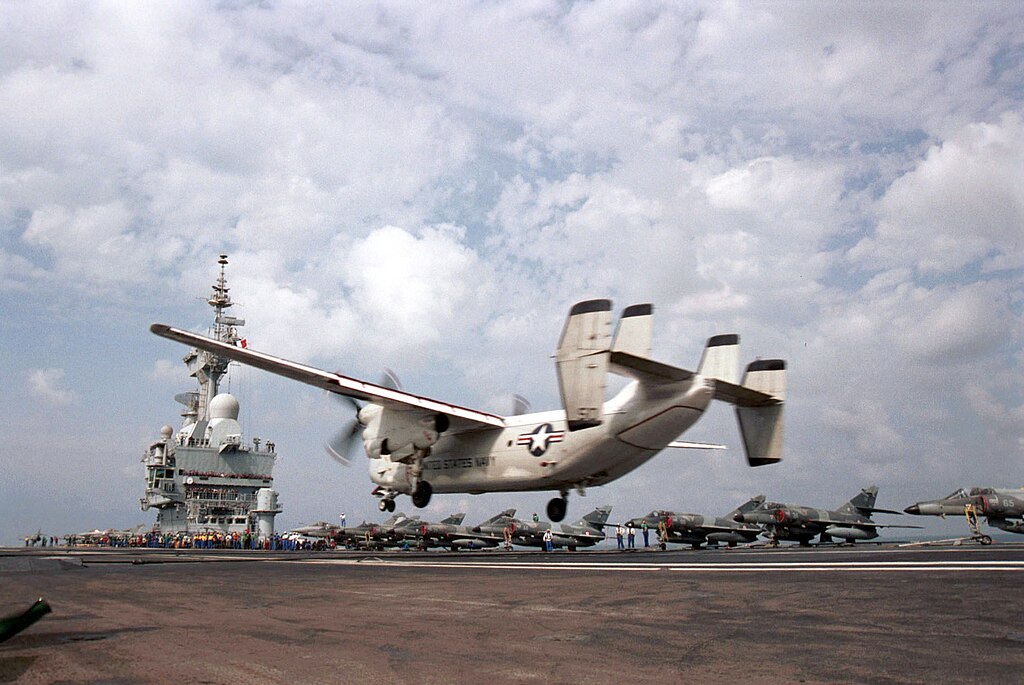
The CdG could also operate the USN standard C-2 Greyhound, which is handy for VIP transport and supply from a US carrier group. This was put to good use in various occasions in several missions. It has a lot of commonality with the Hawkeye already maintained aboard, and so could be supplied and repaired on the French carrier in case. There has been consideration from the start to integrate the F18 Hornet aboard (planned in 1994 as a backup plan if the Rafale was further delayed), and already to integrate a reactor workbench, assorted with parts compatible with the General Electric F404-GE-402 engine for further interoperability. On the same order of idea, tests were made with the V-22 Osprey tilt rotor to replace the Greyhound. It might be used also on CdG in the future (see below).
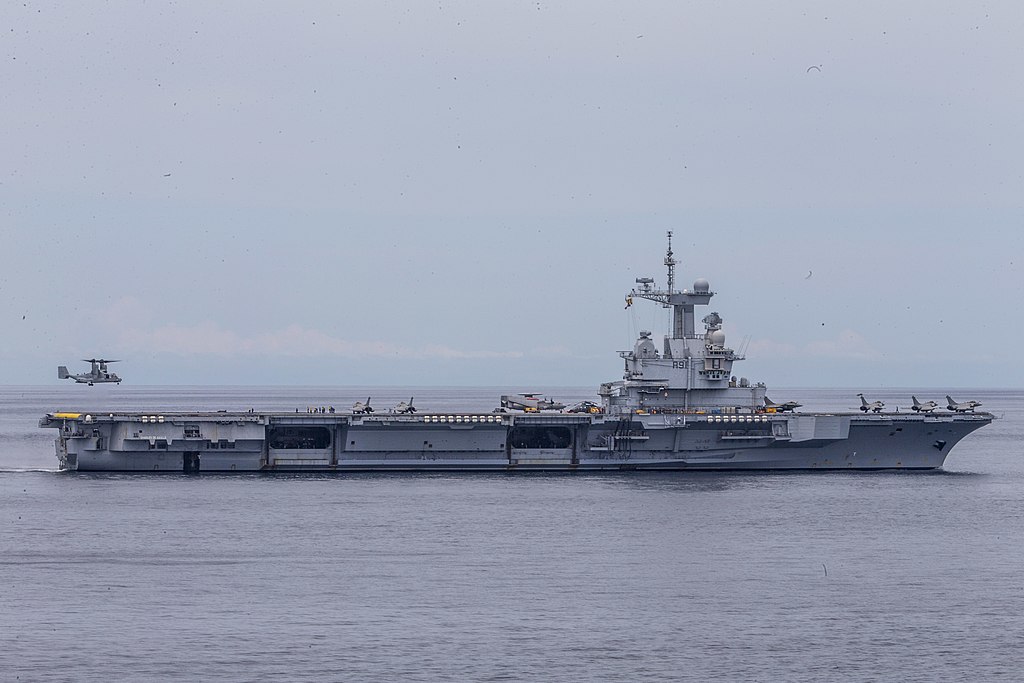
Sensors
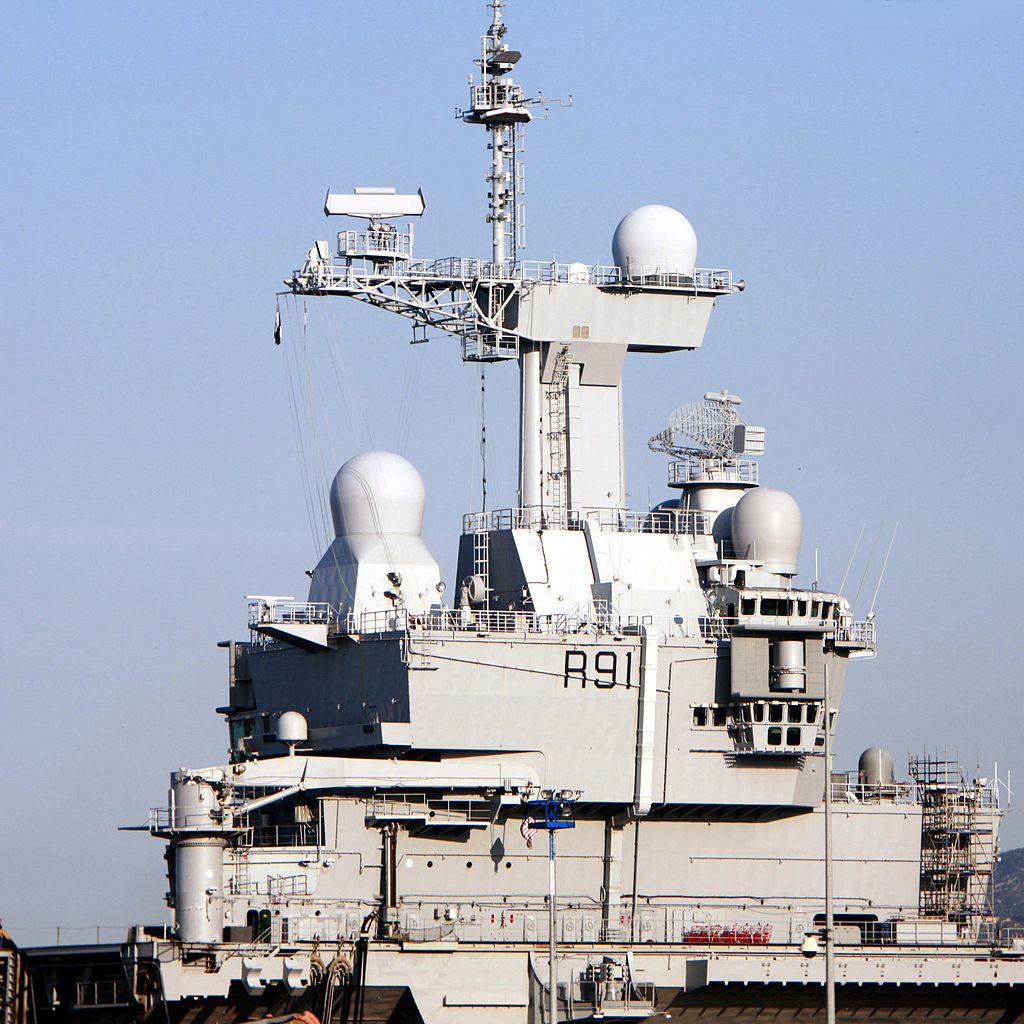
-Three-dimensional air surveillance radar SMART-S MK2 (S-band);
-DRBV-26D long-range air surveillance radar (L-band; range 370 km);
-DRBV-15C Sea Tiger Mk2 low altitude combined surface-to-air surveillance radar (S-band; aircraft range 100 km, missile 50 km);
-ARABEL fire control radar (X-band);
-2 Scanter 6000 multirole radars used for navigation, tactical surface surveillance, helicopter air traffic control and search and rescue (SAR) missions54. ;
-Secondary radar or IFF
-Vampir DIBV-2 Infrared Standby;
-Sagaie missile decoy chaff launchers
-SLAT55 anti-torpedo decoy;
-Electronic warfare suite (ARBR-21 Radar Detector / 2 ARBB-33 radar jammers / ARBG-2 MAIGRET COMINT interceptor);
-Air Navigation System (TACAN) NRBP-20A56;
-Syracuse 3 satellite transmission system, Fleet Satellite Communications System, Inmarsat;
-SENIT8 combat system (link 11, link 16 and exchange gateway between these two tactical data links).
Combat System
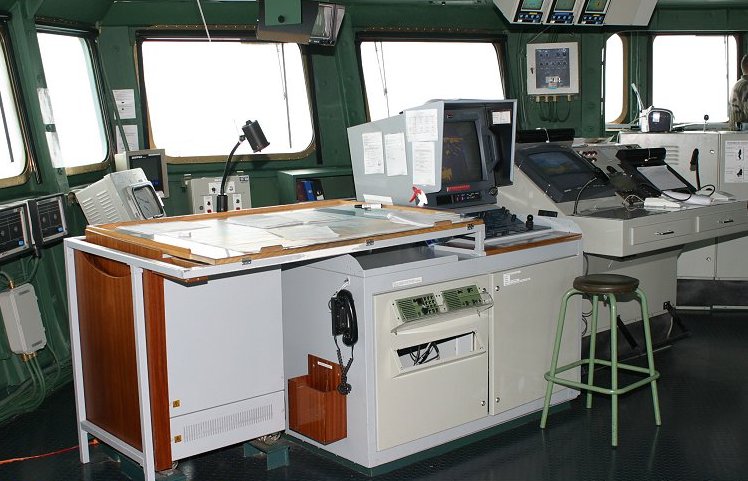
Charles de Gaulle’s SENIT 8 tactical system is the brain of all onboard Weapons System from short to medium range surveillance with the ability to track simultanously track 2,000 air, naval or submarine contacts. The onboard C&C room is able to coordinate the actions of the entire Carrier Strike Group, between frigate, corvettes and submarines.
As for self-defence, the CdG had a four-tiered layered one:
1-Rafale M and its own generous panoply of missiles. The best is the MDBA Meteor, a Mach 4+, 200 km+ (110 nmi) range ordnance with a no Escape Zone of 60 km (32 nmi).
2-The two SAAM Aster VLS with their 32 launchers could be resupplied with a total of 1,550 missiles. It is the second line after the Rafale (Meteor, Mica, Magic). It should be added that the escorting frigates also are equipped with Aster 30 and Aster 15 missiles for the extra defensive layer of the carrier group
3-Two Sadral launchers (short range) 12 Mistral missiles in salvo against an omnidirectional saturating attack on 10 nautical miles
4-Two Mistral missile launchers on tripods forward and aft of the bridge.
5-Three 20mm Nexter Narwhal autocannons. Another satefy net after missilesn they are automated on the incoming target for extra acccuracy day/night.
6-For asymmetric defense, the Charles de Gaulle has five 12.7 mm M2HB Browning with quick barrel change system after the three Narwhal.
On the electronic side, CdG counts on its electronic warfare system and ARBB33 jammers optimized against anti-missile seekers, one ESMARBR-21 and one 1ESM ARBG-2, and four Sagaie chaff launchers, plus an anti-toroeo SLAT decoy.
The ship even has the capacity to defend istelf in case of a surprise boarding of for patrolling around against swimmers and fast boats day and night in hostile areas. There is a permanent detachment of marine riflemen (HK USP 9 x 19 mm Parabellum, FAMAS G2 NATO rifles, FAP Valtro PM pump-action rifles, HK G3 7 sniper rifles with sniper scope, minimi NATO submachine guns, AANF-1 submachine guns) and two to four fast boats for interception. They usually patrol permanently around the ship when anchored in a sensitive area.
There is also a EOD team of 4 deminers on board in case of a booby-trapped parcel was found on board.
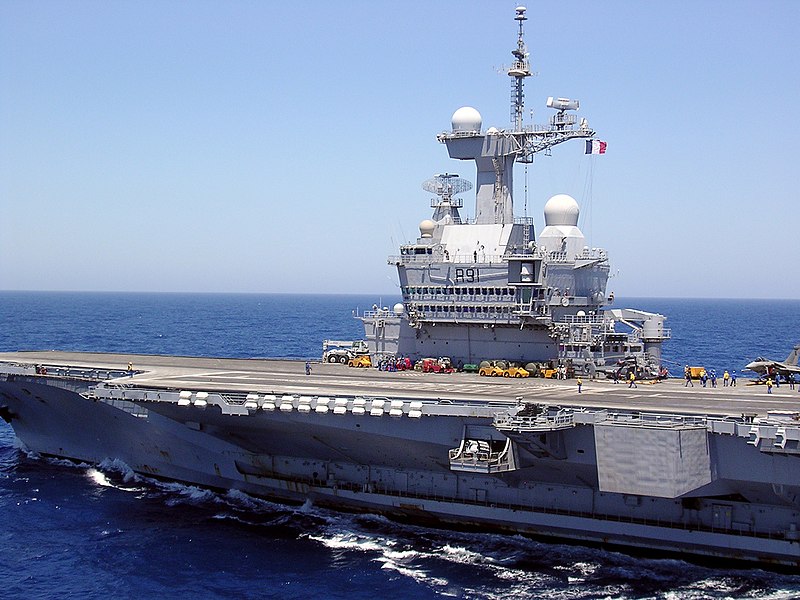
Communication
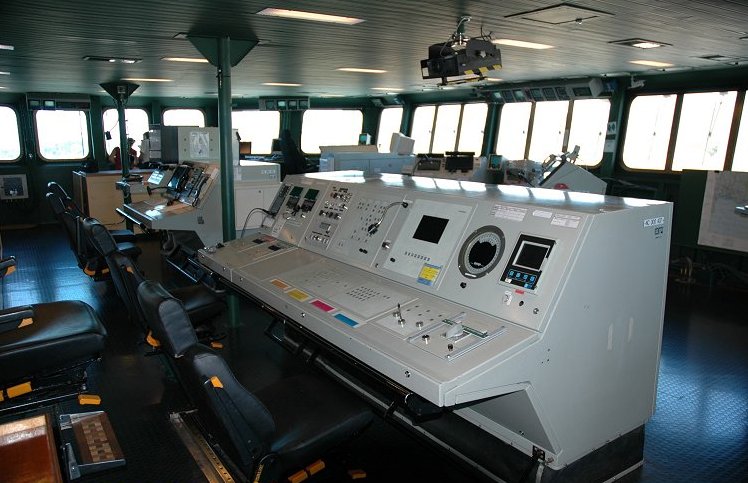
The CdG uses a link 16 tactical data link as a C2 platform for Link 16 Control Participation Group but still supports Link 11 due to older French Naval Air Group Tactical Data Link systems still in service. Multi-link configuration is used (Link 16 + Link 11) thanks to a dataforwarding function allowing data exchange between the two. A satellite link using Satcom Syracuse 3 allows the implementation of the J-Over IP51 Tactical Data Link, JREAP-C for packaged J-series messages under IP. She also has a JICO cell (faraday cage, anechoic walls) for ultra-secured communications. For navugation, in addition to the Satellite-bound Syracuse 3 system, the CdG has three inertial navigation SIGMA 40 PA CDG52 systems by Safran Electronics.
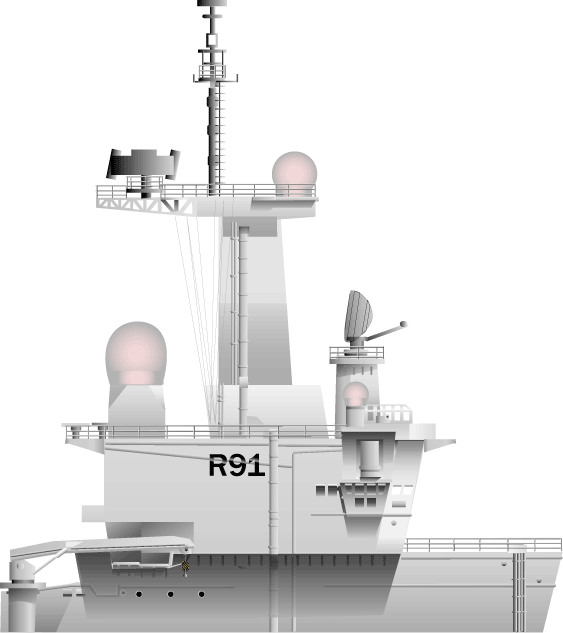

Author’s illustrations of the Charles de Gaulle and island.
⚙ specifications |
|
| Displacement | 42,500 t (41,800 long tons) FL |
| Dimensions | 261.5 x 66.5 x 9.43m (857 ft 11 in x 218 ft 2 in x 30 ft 11 in) |
| Propulsion | 2 shafts K15 PWR 150 MWt, Alstom steam turbines 61 MW, 4 diesel-electric |
| Speed | 27 knots (50 km/h; 31 mph) |
| Range | Unlimited distance, 20–25 years |
| Armament | 4×8 A-43 MBDA Aster 15 SAM, 2×6 Sadral Mistral, 3× Nexter Narwhal |
| Sensors | DRBJ 11 B 3DR, Thales SMART-S MK2, DRBV 26D, DRBV 15C, see notes |
| Protection | NBC, Bulkheads around Nuclear core, ammo storage, see notes |
| Assault capacity | 800 commandos, 500 t ammo, 30+ helicopters |
| Air Group | 40 Max, Rafale M, E2C Hawkeye, see notes |
| Crew | 1,350 ship + 600 air group |
Career of FS Charles de Gaulle
A difficult start
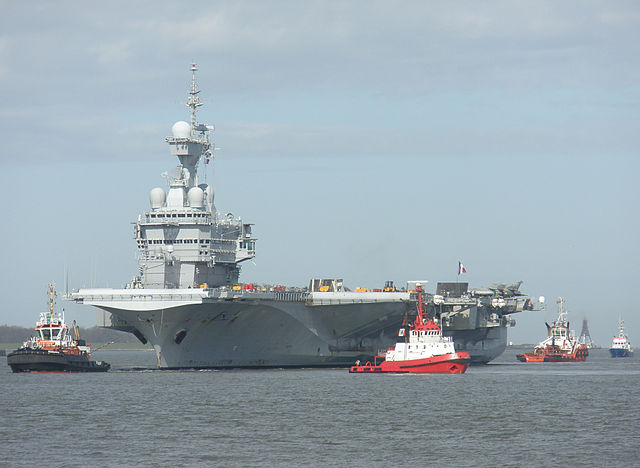
There had been some press-fuelled controversy following issues with the ship post-completion. With hindsight, they can be debunked.
Lengthening of the oblique runway of the flight deck: First sea trials by January 1999 showed the oblique runway was too short to enable landing of an E-2C Hawkeye with degraded configuration. The initial design did not planned the adoption of even the previous generation Hawkeye, while the new one appeared substantially heavier.
Back in 1986, it planned for the Super-Étendard, Rafale Marine, Breguet Alizé and even possibly the F/A- 18 C/D for cooperations missions. But the need for better aerial surveillance/EW was made in 1992, and acquistion of 3 new E-2C Hawkeyes was signed for 6 billion francs. The catapult was still tailored to launch it, landing was possible in most configurations also, but handling at the end of the runway in extreme conditions would have risked slowing down transport to the parking lot and delay air operations with its very large wingspan. So it was not “bad calculations which caused the deck to be too short” as derided by some medias.
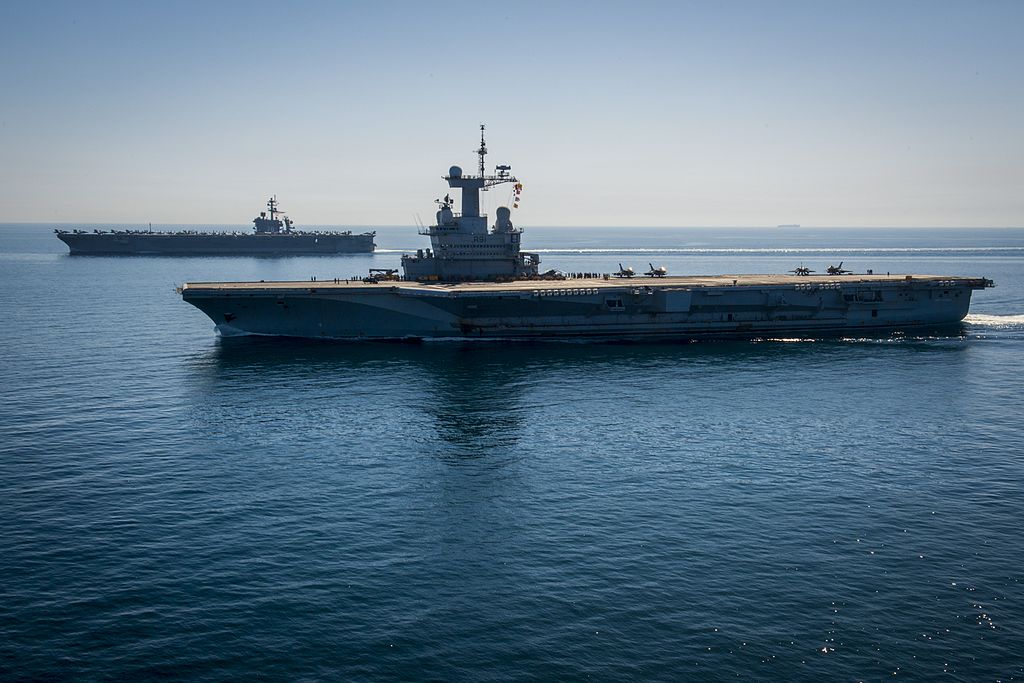
In fact the same work was carried out on the previous Foch and the Clemenceau when the F-8 Crusader went into service and this did raised eyebrows. The same was done for US aicraft carriers over decades, as British carriers, adapted to new air operations and air parks. In addition the cost was 5 million francs at the time, barely 0.025% of total cost.
Rear area vibration: More concerning was a teeething issue with vibrations. Another ‘classic’ revealed by sea trials, but not expected on a strongly built carrier. From March 18-30 1999 during sea trials at full speed, a vibration appeared in the steering gear, but did not prevent reaching 28 knots on constant heading. The aft rudders after tests were moved slightly to be on the axis of the propellers and this cured the issue.
Port propeller broken:
More serious was the braking of the port propeller’s blade in the night of November 9 to 10, 2000, while underway in the western Atlantic to Norfolk, Virginia. She had to be returned to Toulon for a propeller change, with investigation later revealing all had structural defects with shrink marks near the axis. Atlantic Industrie was blamed for using a less experienced staff and so the spare propellers from Foch and Clemenceau were used, limiting top speed to 25 knots. By late 2008 they were replaced by two US-made Rolls-Royce Marine, 20 tons, 6 meters models. The speed loss was an issue to launch the Rafale at full load.
Radiation protection:
Not an issue but a change in requirements to adapt to the latest NBC norms required during the final design and construction work, to enforce ICRP standards, which limited modifications to the reactor’s shielding. The February 28, 2000 tests showed the radiological protection elements too close to the reactor caused an emission of thick smoke, contained. More precise positioning in assembly and improvement of the thermal insulation eventually cured this issue.
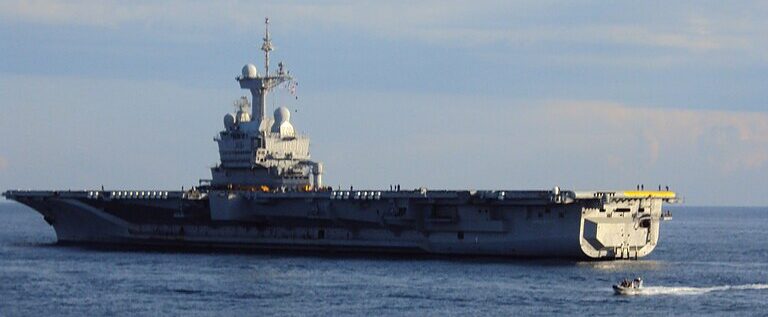
Gas incident:
On November 8, 2001, a quartermaster performing routine maintenance, unblocking a failing check valve on a sewage collection system coffer lost consciousness after inhaling hydrogen sulphide, while the second quartermaster rescuing him also fainted. Since the quartermaster evacuated to Toulon hospital fell into coma, his family filed a complaint to the Navy, leading to an enquiry. It was established that the system in place was not to cause any risk of properly maintained using all satefy prodecures indicated by the constructor. The Marseilles court eventually convinced 3 sailors for “serious negligence”, but was later overulled in appeal.
Start of Operations, 2001
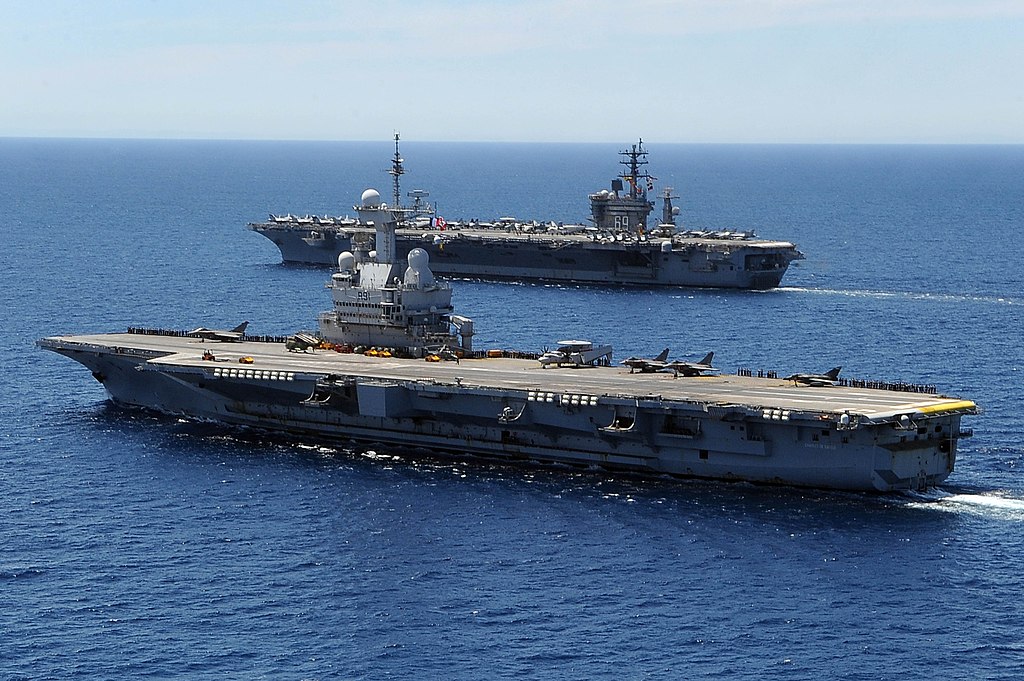
On November 21, 2001, France decided to send the Charles de Gaulle to the Indian Ocean for her first mission, supporting NATO operations in Afghanistan.
Task force 473 was created around the young carrier, carrying 2,900 crewmember under command of Rear-Admiral François Cluzel. The force was underwya on 1 December, with as escorts the frigates “La Motte-Picquet”, “Jean de Vienne” and “Jean Bart”, and the SSN “Rubis”, supported by the oiler “La Meuse” and the sloop “Commandant Ducuing”. At the time, she carried 16 Super-Étendards and one E-2C Hawkeye, as well as two Rafales for their first operational deployment, and several helicopters.
On December 17, 2001, TF 473 took its place in the international armada, alongside USS Theodore Roosevelt and USS John C. Stennis’s own Task Forces as well as the Italian Giuseppe Garibaldi, in total 100 ships, French, American, Canadian, British, German, Italian, Dutch, Australian, Spanish and Japanese coordinated from Bahrain.
Super-Étendards started operations from December 19 between reconnaissance and strikes over a 3,000 km area, 140 missions, 12 daily on average. They were fired at, and escape to, Stinger missiles.
On February 18, 2002, a French Satellite Helios used for observation spotted suspitious activities near Gardêz, later confirmed by American special forces and so Charles de Gaulle launched two Super-Etendards in reconnaissance, follwoed by an incursion on the 20th of British and American forces in the valley. By March 2, Operation Anaconda started, with Super-Etendards supported air strikes against al-Qaeda. Later, the carrier deployed 5 Rafale as well as two KC-135 and two Hawkeye for supprt and by February, she made some plane exchange with USS John C. Stennis. One E2-C Hawkeye from VAW-112 was the first non-French plane to land on CdG. Many more interoperability exercises will follow over the years, as unlike the previous Clemenceau class, the new French carrier was much closer to USN standard, notably for deck space.
War in Iraq and first IPER
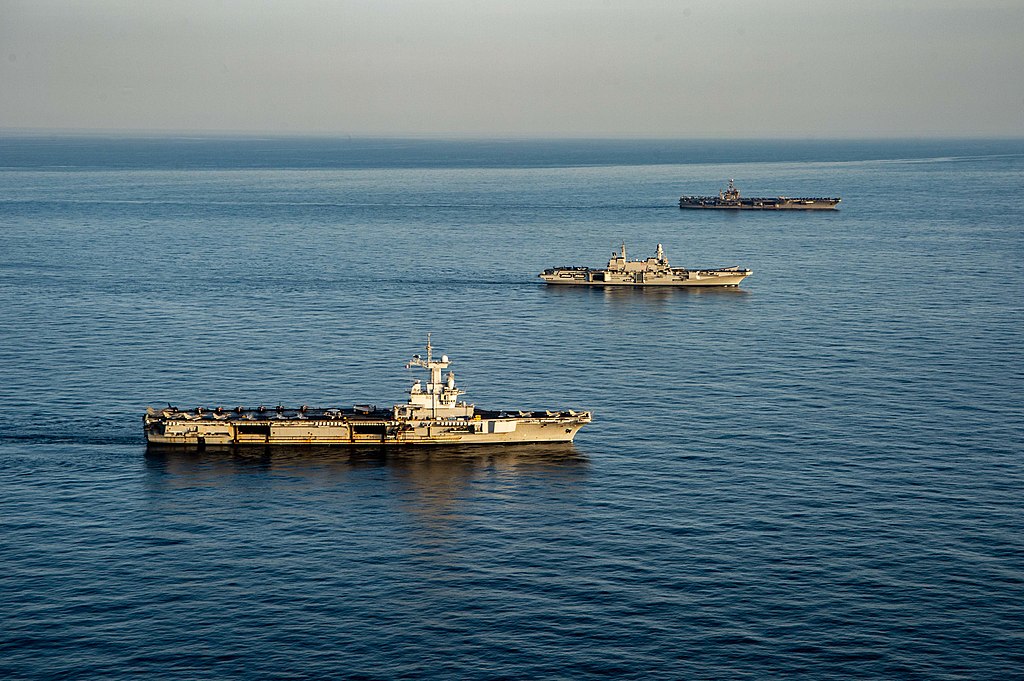
On May 2, FS Charles de Gaulle stopped at Singapore before reaching Oman while tension rose over the question of Iraq. France’s refusal to participate in the invasion of Iraq in 2003 led to an embargo which impacted the maintenance of parts of the catapults of FS Charles de Gaulle, lifted in 2005. That year, the French carrier was at the Portsmouth ceremonies for the 200th anniversary of the Battle of Trafalgar. In between the Carrier stayed in the Western Mediterranean, out of maintenance periods. Since 2001 she was homeported at Toulon.
From July 2007 to December 2008, Charles de Gaulle has its first IPER (Periodic Unavailability for Maintenance and Repairs) before its major technical shutdown planned for 2016. The long immobilization, due to the absence of a second carrier forced the air group to train on land, on a runway shaped as the carrier, at Landivisiau base (Britanny, NW France). Still, it did not replicated the motion of the ship at sea, making it clear that a better solution was to be looked after.
On October 9, 2008, the CrossMed Regional Operational Center for Surveillance and Rescue in the Mediterranean communicated the distress call from a 8m ship, Babolin, which was rescued by the carrier maneuvers in this sector; An helicopter rescued the crew of three in 35 knots winds, heavy waves and poor visibility.
Back in service: 2008-2009
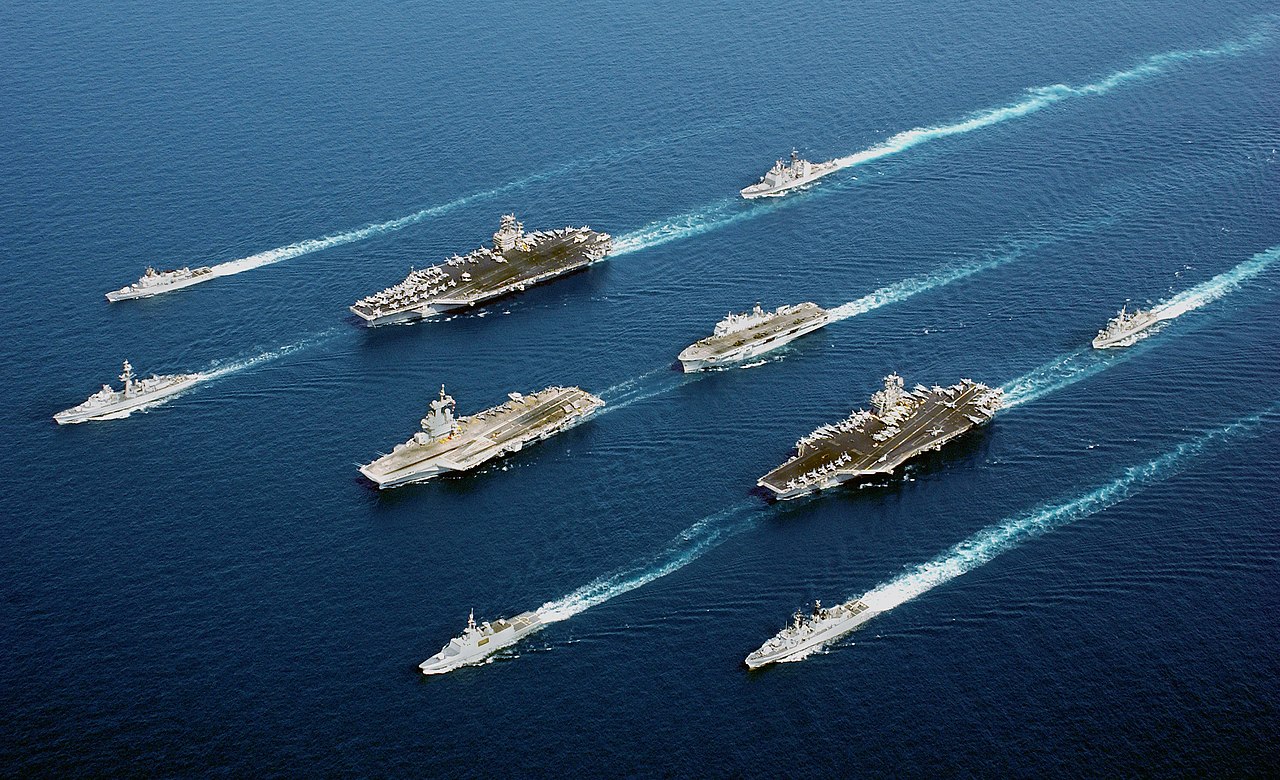
During her overhaul in 2008 was observed the premature wear of parts of the propulsion system, which delayed the completion of this IPER in 2009. It was follwoed by operational conditioning exercises to regain all essential qualifications, notably for the Air group back from Landivisiau. Bt April 2010 she made a tour of exercizes in the North Sea, to test her maximum air group capacity of while being part in a 40 ship fleet (11 NATO countries) and Sweden as a gues. It was exercize Brilliant Mariner preparing for the Alliance activation of its rapid reaction force (or NATO Response Force). On July 1, CdG took the 15th round of alert and assumed command of the NRF 15 for six months, as the TF core. Its air group was reduced to 12 Super Étendard, 7 Rafale, 2 Hawkeye, and 2 Dauphin.
At this occasion she pushed north and crossed the Arctic Circle on Saturday April 17, 2010. This was not a planned move but the the consequence of the ash cloud resulting from the Eyjafjöll volcano ureption in Iceland, which disrupted air operation. The carrier just moved north out of reach.
Operation Agapanthe (Enduring Freedom)

After post-maintenance testings to confirm her operational status, the carrier reconstituted TF 473 for the Agapanthe 2010 mission, in Afghanistan. This time her air group mostly comprised Rafales and she carried out 180 missions as part of Operation Enduring Freedom. It was concluded in the Indian Ocean by the Varuna exercise with the Indian Navy. It was followed later back in the Mediterranean, to Operation “Harmattan” over Libya, enforcing UN Security Council Resolution 1973. On April 4, 2011, the carrier also celebrated her 342,000 nautical mark.
Before Agapanthe, she left Toulon on Wednesday October 13, 2010 but was back on October 15 for some testing offshore and extra training before deployment. Notably a an insulation fault on an electrical cabinet controlling safety valves in thee propulsion was to be corrected before departure. The valve was just changed the problem fixed.
She was underway for good on October 30, escorted by the frigate “Tourville” the air defense frigate “Forbin” supported by the oil tanker “La Meuse” and SSN “Amethyste”. She lost a Rafale on November 28, 2010, crashing shortly after catapulted. She kept 9 Rafales (12F flotilla), 12 Super-Etendards (17F), two Hawkeyes (4F) and a small helicopter group, performing 180 sorties over Afghanistan until December, her part in Operation Enduring Freedom. Close air support missions were mostly done without dropping ordnance, assortied with many sorties in reconnaissance missions or air traffic control.
Operation Harmattan
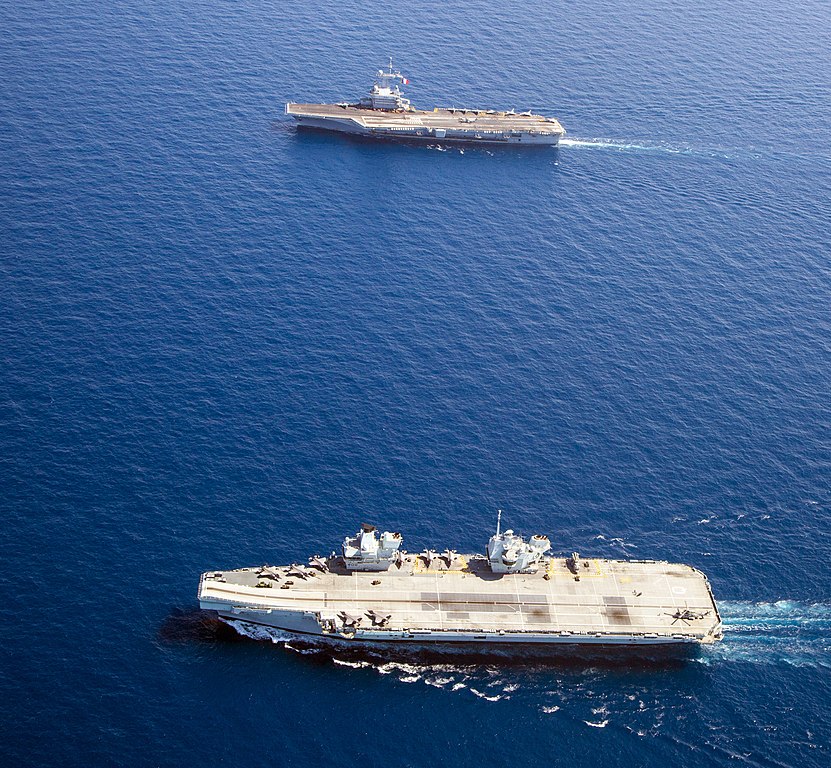
The “Harmattan” operation in Libya was a direct application by decision of President Sarkozy of UN resolution 1973 about the civil war in libya, to overthrow President Ghadaffi. Underway by March 20, 2011, TF 473 (1 SSN, 3 frigates (Dupleix, Forbin, Aconit) she could bring her air group close to the action: 10 Rafale M Block II, 6 Super-Étendard, 5 helicopters, 2 Grumman E-2 Hawkeye, two leased Grumman C-2 Greyhound from the US Navy, the latter for logistics rotations. After the mission was completed, she was back in Toulon on August 12, 2011, greeted by the French president and entered drydock for a short overhaul. In total her air group and in particular the Rafales, depliyed with live ordnance for the first time, performed 1,350 sorties and 3,600 flight hours in 120 days. 840 attack were performed mostly on Ghadaffi’s loyalist forces.
A Complicated mid-life maintenance
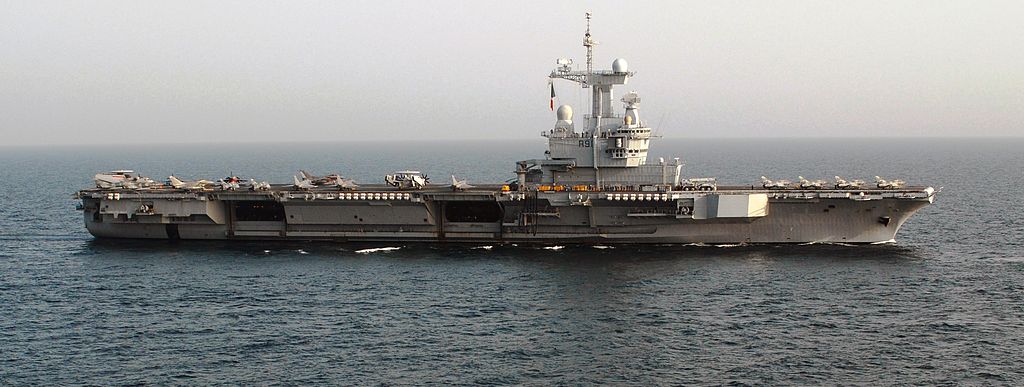
Then came her first planned major periodic maintenance, IPER and ATM, performed every decade. This consisted of full nuclear reactor refueling and in-depth modernization, which implied a “major technical shutdown” lasting 18 months. This included 80,000 lines of work. The most crucial were the replacement of the fuel elements of her two nuclear cores. However the observed unexpected premature wear on a shaft line urged replacement of these parts and a longer IPER than planned. Delays were later commented by a parliamentary report, as the original design in the 1990s being based on available scientific and industrial data fed by existing feedback from the USN. But the French aircraft carrier had its own line of specifics in torque and speed and a new limit was set of 20,000 hours, not 100,000 as initially planned. DCNS performed the IPER/ATM for 10 million euros.
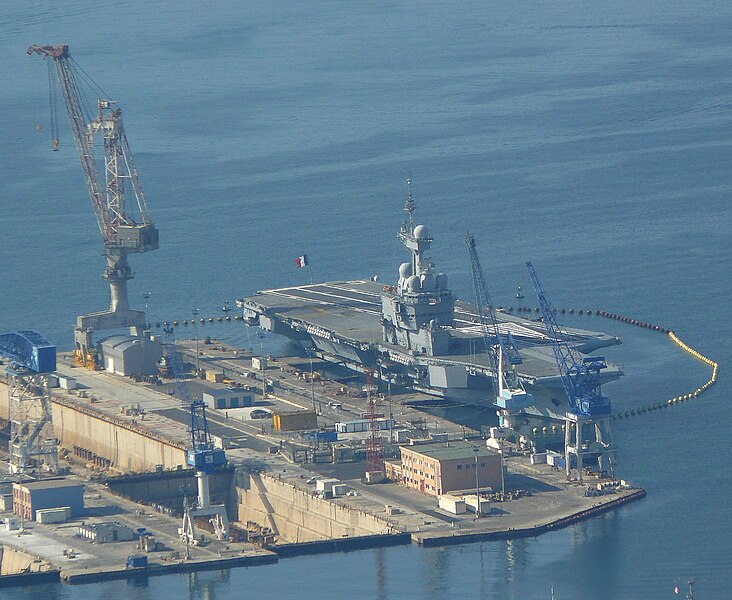
This uncluded the Runway complete re-coating (runway paint proved too abrasive for the new brake cables). It was done over the whole landing area, part of the flight deck with a new paint increasing grip of nose gears during landings. It was applied after tests to the taxiing and parking area later in 2013.
In 2012, the ship proceeded to a serie of qualifications to regain active service. She stayed at Toulon and cruised in the immediate area, comprising the Thyrrenian sea, Corsica-Sardinia.
2013 IEI, and 2014-2016 Operations

The carrier went through a period of unavailability for intermediate maintenance (IEI) at Toulon from January to August 2013, after her post-IPER; in order to complete training in the Mediterranean with the battle group? By August 2013 she reached full operational qualification, ready for projection operation. By default of an active theater of war, she was sent for complex manoeuvers, in the Indian Ocean: This was Operation Bois Belleau, named after an earlier French carrier of the Indochina era. This became a new tradition for such deployments.
From November 20, 2013 to February 18, 2014, FS Charles de Gaulle’s Bois Belleau operation was held in the northern Indian Ocean and Arabo-Persian Gulf. She got there cia Suez, and performed maneuvers for five weeks, with the US Carrier Battle Group CSG-10 (USS Harry S. Truman). Later in 2014 she was back in Toulon for a short maintenance a crew’s rest for the new year.
Mission Arromanches and Chammal were soon to take place the newt year in 2015.
On January 26, 2015, “battle group Arromanches” (Frigate Chevalier Paul, oiler Meuse, HMS Kent, SSN Améthyste) crossed the Suez Canal to the Indian Ocean and by February she entered the Persian Gulf for operation Chammal, taking part in the coalition against ISIS. She operated her for five months, including eight weeks in the Gulf area. By April 12-16 she provided support for one of the American aircraft carriers. On April 19, she left the area for Goa, India and participate to Exercise Varuna 2015, with the Indian Navy. She was back in Toulon via Suez later that year.
On November 18, 2015, FS Charles de Gaulle left Toulon for Arromanches II, eastern Mediterranean, close to the Syrian coast after being planned initially for the Persian Gulf. Her group comprised two French frigates (La Motte-Piquet, the air defense frigate Chevalier Paul), a Belgian one (Léopold I), a German one (Augsburg), a british one (HMS Defender) latr reinforced by an SSN and supply vessel. She carried 32 aircraft (18 Rafale M, 8 Super-Étendard -last deployment-, 4 helicopters, 2 Grumman E-2 Hawkeye). She passed the Suez canal on December 7, 2015 and arrived in the Persian Gulf as flagship, Task Force 50, to fight ISIS. France’s commitment made it the first European Task Force to undertake the same tasks as a standard USN task force. On December 18, her battle group crossed the Strait of Ormuz. She hosted US Secretary of Defense Ashton Carter on December 19, and resumed operations against ISIS.
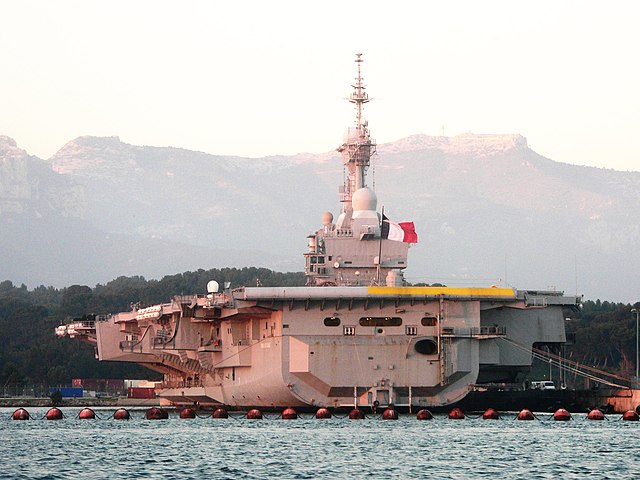
On September 19, 2016, Charles de Gaulle and her carrier battle group sortied again for Arromanches III. The Frigates Chevalier Paul, Cassard, Jean de Vienne, FGS Augsburg, USS Ross, oil tanker Marne and one SSN sailed from Toulon to another TOD against ISIS, before her major technical stop. In mid-November, Forbin relieved Chevalier Paul, USS Mason relieved USS Ross. Later Cassard and ugsburg were relieved by La Fayette and Guépratte. 12 different ships protected the carrier during Arromanches III.
Again she was flagship, Task Force 50, receiving the American distinction Meritorious Unit Commendation on June 23, 2016. This time she operate her planned air group, 30 aircraft (24 Rafale M, 4 helicopters, 2 Grumman E-2 Hawkeye). Analysts estimated the capabilities of the 24 Rafale was equivalent to 48 Super-Etendards. The fine tuning of the maintenance crews also reached full maturity, as sorties were done with a 95% availability at all times. If France had an equivalent to the “Battle E” for efficiency, it would have certainly be awarded. A good way to conclude this mid-decade before a long absence.
2017 Major IPER and Modernization
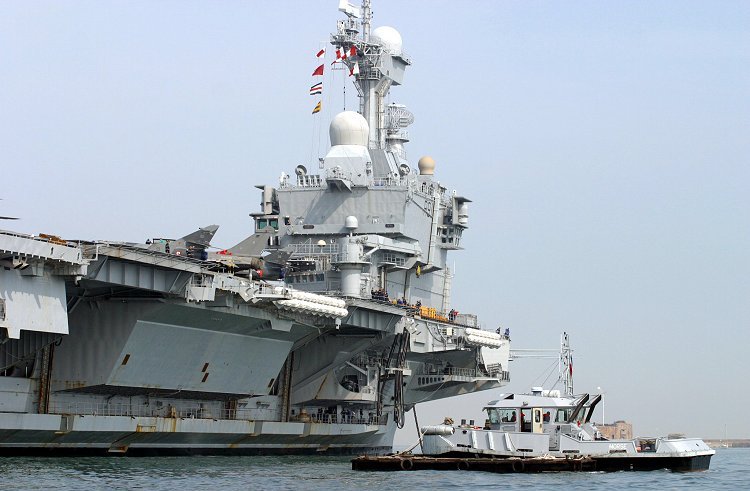
In 2017, Charles de Gaulle entered the dry dock in Toulon for a while. This was to be her second major scheduled maintenance period, wholesale modernization, which will left the country for eighteen months without its flagship. Naval Group (Former DCNS) was in charge of the complex overhaul. It was also made with the General Directorate of Armaments (DGA) and Fleet Support Service, budgeted for 1.3 billion euros and including 2,100 personal, including subcontractors. 1,100 Charles de Gaulle crew members also worked on the site (Like for US Carriers long overhauls). They lived in a protected area of 280,000 m2 around the dry dock (Vauban basins, Toulon).
Overall, 200,000 lines of work were noted, includng the replacement of fuel elements of the two K15 nuclear core, full replacement of sensors, new digital networks, new racks and computer servers, upgraded SENIT 8 Combat Management System revised for better NATO integration and in particular leaning towards US Carrier Strike Groups standards.
The Central Operation was completely modernized anew, with new screens and consoles, notably large digital touch tables.
The telecommunications were also renewed, the whole intercom, Integrated Navigation and Alignment Systems with new Safran inertial units.
The DRBJ-11B radar (S band, radome, rear of the island) was replaced by a SMART-S 3D surveillance radar from Thales for three-dimensional air surveillance of 500 tracking at 250 km (20% more range). The still efficient DRBV-26D and DRBV-15 radars were retained as complementary. The SMART-S has been scheduled for rpelacement by 2028.
The two Racal-Decca DRBN-34A navigation radars were replaced by Scanter 6000 multirole radars.
Safran’s EOMS NG multifunction optronic system (IRST infrared surveillance and tracking) was installed, better notably for asymetric warfare.
Thales Artemis panoramic system was installed, cabable of tracking 200 conventional or asymmetrical threats.
A new IFLOLS landing mirror system was installed.
Everything woncerning the Super Etendard has been removed and better optimization for the maintenance of an all-Rafale group performed.
The process ended officially on September 14, 2018, on budget and schedule.
Mission Clemenceau
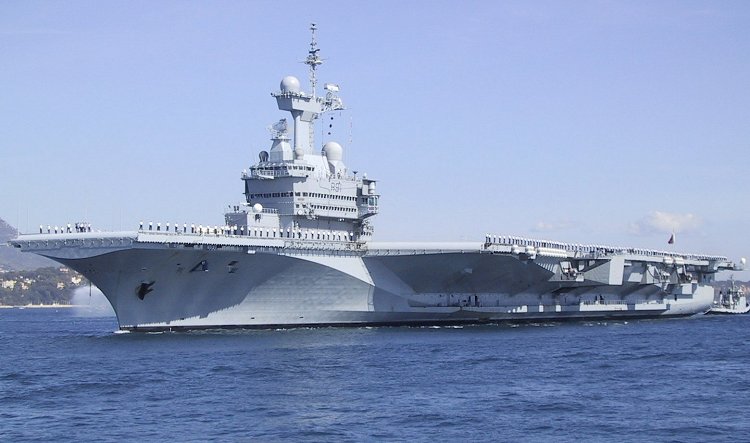
After Bois Belleau, and Arromanche it was time to choose a more modern carrier name as mission. This was Mission “Clemenceau” to sign the return of TF 473 by 2019.
It’s on March 5, 2019 to July 7 that CdG was deployed across the Mediterranean, crossed the Suez Canal and went to Singapore, for further operations against Daesh (Operation Chammal). She stayed a month in the eastern Mediterranean, until the fall of Baghouz, last bastion of Daesh.
She then took part in a bilateral exercise with the Carrier strike group, USS John C. Stennis, in the Red Sea. This was a good way to see of the modifications made for interoperability with US carrier groups was worth its weight. There were notably planes and personal exchanges during this time.
This was followed by a sweep in the Indian Ocean for exercise Varuna in May 2019. Thuis time it was a two-carrier effort, with INS Vikramaditya strike group. This was concluded by bilateral and multilateral exercises “La Pérouse” with Japan, Australia and the United States in the Bay of Bengal. By the fall of the summer, CdG was back to Toulon via Suez.
On January 21, Charles de Gaulle departed for her first “Foch” mission, marked by a stay in the Mediterranean Sea and a second with a return in the Atlantic Ocean. On April 5, she crossed the Strait of Gibraltar for the first time in a decade, taking part in nothern sea NATO exercises. A good way to test interoperability with multinational forces.
Back in the Eastern Mediterranean, she spent 3 weeks as part of the coalition against the Islamic State, still Operation Chammal. Her carrier battle group comprised again a single SSN, and nine French and Foreign surface ships (The new Frigates Bretagne, Normandie, Chevalier Paul assisted by the oil tanker Somme) as well as the Bundesamrine’s Lübeck, Belgian Léopold I and Portuguese Corte Real. She made a test of launching 12 Mistral in rapid salco on a target simulating an incoming missile. She returned from her Atlantic exercises in Brest arsenal (March 13-16, 2020). The Covid-19 hit hard in France, and Family visits as well as the traditional “family day” were cancelled this year. Sailors were however authorized to go ashore on leave, but this was later paid by an outburst.
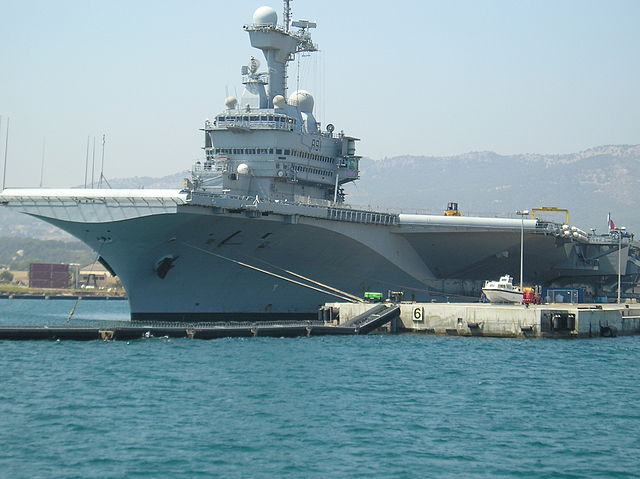
The carrier soon took part in exercize “Frisian Resilience” in the North Sea (5 days), and for the first time, had 4 Rafales tactically controlled by a Hawkeye and Chevalier Paul defended the carrier battle group against ten Dutch F-16s and two F-35s. The Belgian frigate Léopold I and Bretagne, Normandie were replaced by the Danish Niels Juel and La Motte-Picquet.
On April 8, 2020, the French MoD announced a “quarantine” on the carrier. Operations were cut short and the aircraft carrier and escorts had to return to their home ports as quickly as possible. Procedures in place limited the spread while the Health Service airlifted meds on board. On April 10 cases were confirmed on Charles de Gaulle with 50 over 66 cases being positive. 3 sailors were evacuated for urgent treatment at Sainte-Anne hospital in Toulon. Masks became mandatory on board. She ship remained in Toulon and sailors infected were evacuated on several sites in 48h. Decontamination operations were perifmed by the 2nd dragoon regiment and marine firefighters from Marseille. Later it was admitted that 668 sailors had been tested positive and 32 evacuated.
Three investigations were conducted, one headed by Admiral Christophe Prazuck, CNO and Vice-Admiral Gilles Humeau as well as an epidemiological survey and by Army General François Lecointre, CiC Armed Forces. The origin of the contamination could not be established although likely related to a stop in Brest on March 13-16 and family contacts there. Later, it was linked to a stop in Cyprus at the end of February, with contaminations possible from Sicily, Balearic Islands, Spain and Portugal.
Clemenceau 2021, 22 and future Operations

Charles de Gaulle departed for “Clemenceau 21” mission (a new denomination) on February 21, 2021, for several months in the Mediterranean, Indian Ocean and Persian Gulf. She was scheduled back in June. Nothing notable on these.
By February 1, 2022 the French carrier group departed again this time for “Clemenceau 22” mission from February to April 2022 (Forbin, Alsace, Normandie, one SSN, Oiler Durance). 3 other allied ships as well as another submarine joined TF 473. On February 21, she was flew close by a Russian aircraft based in Syria. On March 3, 2022 she was deployed for “deterrent” missions in the context of the recent tensions between Russia and Ukraine. She was used for the protection of the South-East flank of NATO, alongside the Cavour Carrier Group, and Harry S. Truman Carrier Group. They were depliyed notably for CdG to recinforce the air cover of Romania and Bulgaria. On April 8, 2022, the carrier returned to Toulon.
As for now, 2023: By November 2022, CdG sortied for Mission “Antares” (15 novembre), to the Indian Ocean. This was marked by the flight of three Rafale to Singapour, 4,000 km (operation Rastaban) assisted by an A330 MRTT to take part in exercises with the Singaporian AF. She trained with 23 countries between the region and the Mediterranean, crossing 28,000 nm, performing 2,000 launchings, ending with Operation Orion over 110 days at sea. This was followed by new pilots qualifications.
By March 2023 was announced a new incoming 8-months IPER, with the full renovation of the hospital, nuclear core maintenance, shafts, hull, accomodations renovation, installation of the Syracuse 4 Satcom system. This is going on until December 2023, whereas HMS QE2 is also in a similar refit, leaving Europe a bit “short” on carriers at a time of war between Ukraine and Russia (on a background of ever increasing tensions and arms race in Asia) and possible escalation. Future will tell. This article will be updated in the future.
Read More
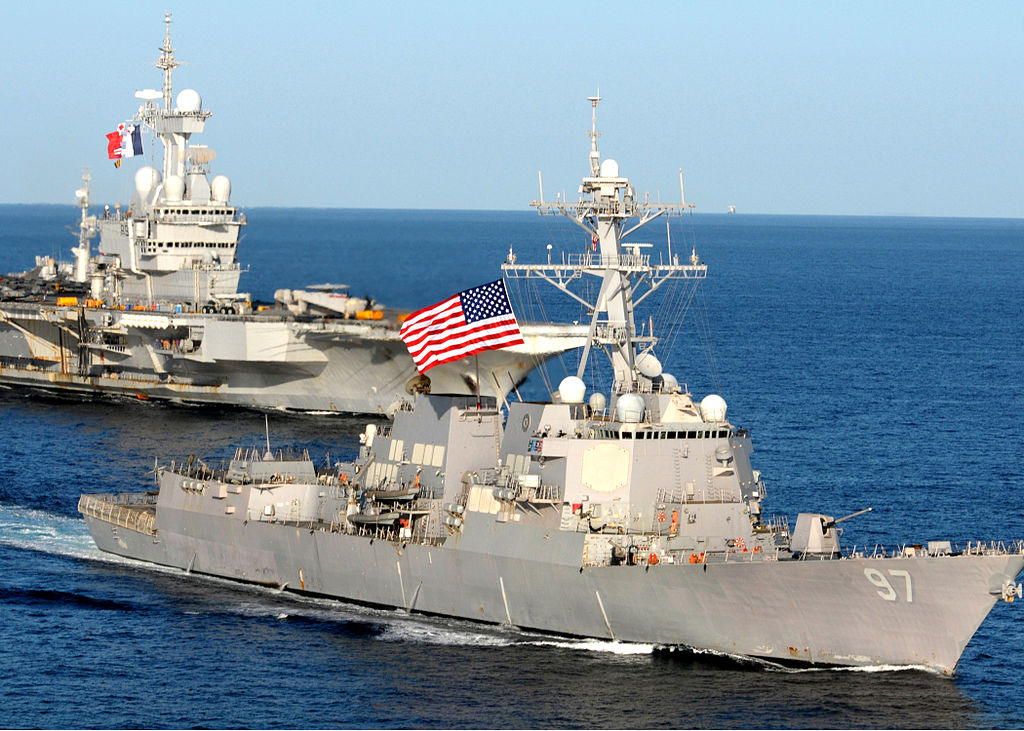
USS Halsey (DD-G97) assigned to USS Abraham Lincoln Strike Group sails with CdG
Books
Michel Bez, Le porte-avions Charles de Gaulle, Éditions du Chêne, 1998
Frank Jubelin, Roger Vercken, Le porte-avions Charles de Gaulle, éd. SPE Barthélémy, 2000
Jean-Michel Guhl et Michèle Alliot-Marie, Le porte-avions Charles-de-Gaulle : Tome 3, Son groupe aérien embarqué, SPE Barthélémy, 2005, 399 p.
Alexandre Sheldon-Duplaix, Histoire mondiale des porte-avion à nos jours, éd. ETAI 2006
Bulletin d’étude de la Marine, l’aéronautique navale, les ailes de la mer no 46, octobre 2009
SPE Barthélémy, Le porte-avions Charles de Gaulle : 15 ans de missions, SPE Barthélémy, coll. « CDG », 2016, 248 p.
Cyril Hofstein (Hauteur) et Benjamin Decoin (Photographies), A bord du Charles de Gaulle, E/P/A, coll. « Hors collection », 2017
Links
weaponsystems.ne: Sadral
en.wikipedia.org F2 Gun
on defense.gouv.fr/
Charles de Gaulle – en.wikipedia.org
navypedia.org/ charles de gaulle
on ihedn.fr/
on usinenouvelle.com
militaryfactory.com/
itamilradar.com
origins on secretprojects.co.uk/
On Pinterest
News
naval-technology.com/
navalnews.com/ Charles de Gaulle
on news.usni.org
navalnews.com/
businessinsider.com/
key.aero/fs-charles-de-gaulle
navyrecognition.com/
localisation on latitude.to
on navalpost.com
theaviationgeekclub.com/
thedefensepost.com/
on navaltoday.com
on c6f.navy.mil/
on stripes.com/
3D
See also
3dhorse.com/
superhivemarket.com/
Model Kits

Can’t go wrong with French specialist Heller. Linked directly to store. 1:400 kit, 66cm long kit.
But it was done also by Kitech at 1:600, HP-Models 1:700 while M-Models produced an array of 1:35 and 1:72 accessories for scratchbuilt radiocommand models.
Model Kits



 Latest Facebook Entry -
Latest Facebook Entry -  X(Tweeter) Naval Encyclopedia's deck archive
X(Tweeter) Naval Encyclopedia's deck archive Instagram (@navalencyc)
Instagram (@navalencyc)





 French Navy
French Navy Royal Navy
Royal Navy Russian Navy
Russian Navy Armada Espanola
Armada Espanola Austrian Navy
Austrian Navy K.u.K. Kriegsmarine
K.u.K. Kriegsmarine Dansk Marine
Dansk Marine Nautiko Hellenon
Nautiko Hellenon Koninklije Marine 1870
Koninklije Marine 1870 Marinha do Brasil
Marinha do Brasil Osmanlı Donanması
Osmanlı Donanması Marina Do Peru
Marina Do Peru Marinha do Portugal
Marinha do Portugal Regia Marina 1870
Regia Marina 1870 Nihhon Kaigun 1870
Nihhon Kaigun 1870 Preußische Marine 1870
Preußische Marine 1870 Russkiy Flot 1870
Russkiy Flot 1870 Svenska marinen
Svenska marinen Søværnet
Søværnet Union Navy
Union Navy Confederate Navy
Confederate Navy Armada de Argentina
Armada de Argentina Imperial Chinese Navy
Imperial Chinese Navy Marinha do Portugal
Marinha do Portugal Mexico
Mexico Kaiserliche Marine
Kaiserliche Marine 1898 US Navy
1898 US Navy Sovietskiy Flot
Sovietskiy Flot Royal Canadian Navy
Royal Canadian Navy Royal Australian Navy
Royal Australian Navy RNZN Fleet
RNZN Fleet Chinese Navy 1937
Chinese Navy 1937 Kriegsmarine
Kriegsmarine Chilean Navy
Chilean Navy Danish Navy
Danish Navy Finnish Navy
Finnish Navy Hellenic Navy
Hellenic Navy Polish Navy
Polish Navy Romanian Navy
Romanian Navy Turkish Navy
Turkish Navy Royal Yugoslav Navy
Royal Yugoslav Navy Royal Thai Navy
Royal Thai Navy Minor Navies
Minor Navies Albania
Albania Austria
Austria Belgium
Belgium Columbia
Columbia Costa Rica
Costa Rica Cuba
Cuba Czechoslovakia
Czechoslovakia Dominican Republic
Dominican Republic Haiti
Haiti Hungary
Hungary Honduras
Honduras Estonia
Estonia Iceland
Iceland Eire
Eire Equador
Equador Iran
Iran Iraq
Iraq Latvia
Latvia Liberia
Liberia Lithuania
Lithuania Mandchukuo
Mandchukuo Morocco
Morocco Nicaragua
Nicaragua Persia
Persia San Salvador
San Salvador Sarawak
Sarawak Uruguay
Uruguay Venezuela
Venezuela Zanzibar
Zanzibar Warsaw Pact Navies
Warsaw Pact Navies Bulgaria
Bulgaria Hungary
Hungary

 Bundesmarine
Bundesmarine Dutch Navy
Dutch Navy Hellenic Navy
Hellenic Navy Marina Militare
Marina Militare Yugoslav Navy
Yugoslav Navy Chinese Navy
Chinese Navy Indian Navy
Indian Navy Indonesian Navy
Indonesian Navy JMSDF
JMSDF North Korean Navy
North Korean Navy Pakistani Navy
Pakistani Navy Philippines Navy
Philippines Navy ROKN
ROKN Rep. of Singapore Navy
Rep. of Singapore Navy Taiwanese Navy
Taiwanese Navy IDF Navy
IDF Navy Saudi Navy
Saudi Navy Royal New Zealand Navy
Royal New Zealand Navy Egyptian Navy
Egyptian Navy South African Navy
South African Navy






























 Ukrainian Navy
Ukrainian Navy dbodesign
dbodesign